The New Temples of Wine
last update: 15 September 2021
The Gehry building of Marqués de Riscal might be today's best known example of "starchitect" architecture in a Spanish vineyard, but it was certainly neither the first, nor the last.
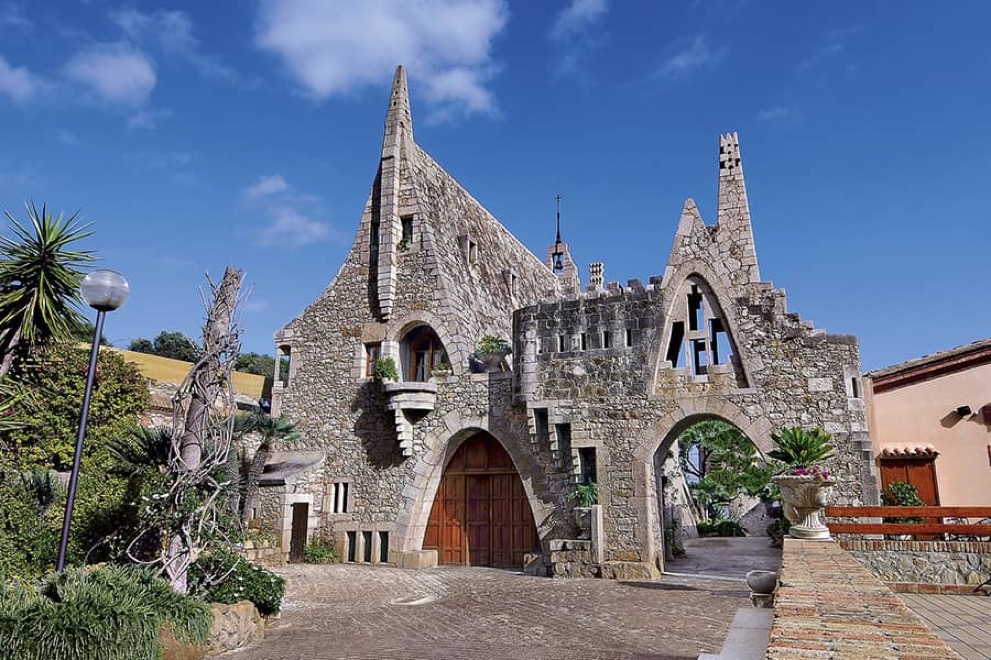
In 1874 the industrialist Eusebi Güell acquired a large estate of 825 hectares to the south of Barcelona, on a very rocky coastal area between Sitges and Castelldefels. He intended to channel an underground spring towards the capital, whilst cultivating some old vineyards and exploiting a limestone quarry. In 1882, Güell entrusted Antoni Gaudí, whom he had known since 1878, with the project for a hunting lodge where he could invite his friends. It was never built, but thirteen years later, in 1895, Güell commissioned Gaudí to build wine cellars in the same place. What Gaudí actually built was a tent-like multi-functional building over five floors, where the two underground floors were wine cellars. The ground floor held the coach house and the servants’ quarters, and first floor was the family residence. The very narrow highest floor was a chapel, with a loggia-style belvedere looking out the sea. Twenty years later the phylloxera infestation would devastated the vineyards resulting in the end of the wine cellar’s activity.
In 1885 a certain Manuel Raventós inherited the families cava-producing company called Bodegas Raventós Cordorníu at Sant Sadurní d’Anoia.
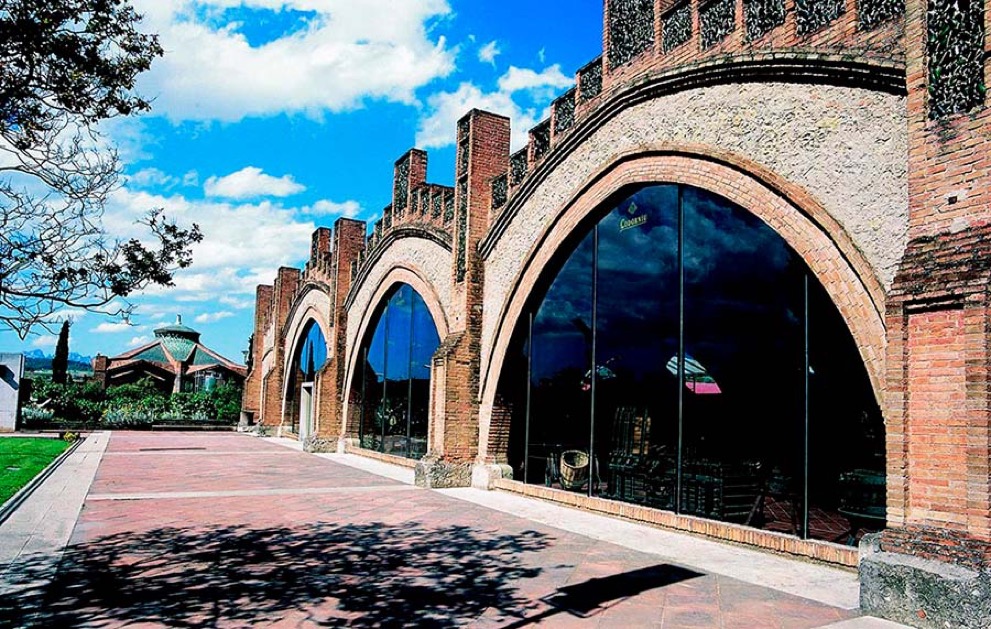
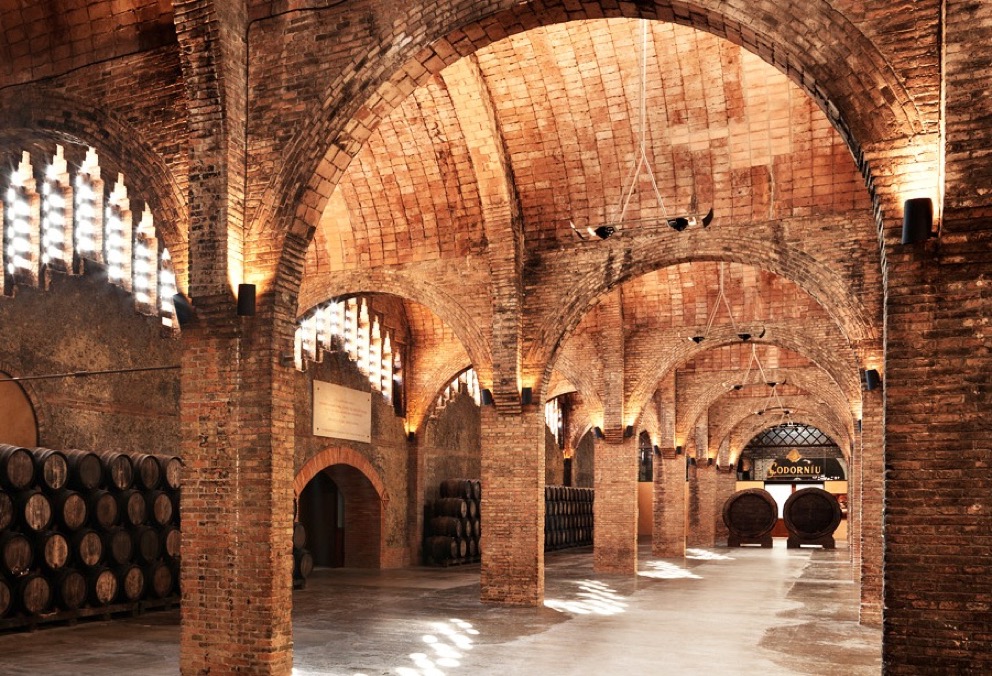
As the business expanded, in 1895, he hired the architect Josep Puig i Cadafalch to design and erect what is now the emblematic building of the company. Even though it accumulates some restorations, the structure inaugurated in 1915, was declared a Monumento Histórico Artístico Nacional in 1976.
In 1776 a certain William Garvey visited Cádiz to buy merino sheep for his herd. Instead he stayed and established himself as a (wine) merchant, first in Sanlúcar and later in Jerez. At the time the lighter Fino-style wines became more popular and started to be exported. Until then they were considered inferior to brown sherry (mostly blends of Oloroso with Pedro Ximénez) and to Amontillado. The rare Finos were made exclusively for local consumption or to produce vinegar. Later his son Patrick would achieved commercial success with his wine called Fino San Patricio. Garvey was probably the first to successfully market a Fino wine as we know it today. San Patricio (Saint Patrick) was also the name of the Bodega San Patricio, the largest warehouse in Jerez at the time, holding around 8,000 casks. It was demolished in 1997 to make place for a supermarket.
Already in the 1840's and 1850's Garvey was the biggest shipper in Jerez, and in 1970 they built the Complejo Bellavista, a giant modern bodega complex designed by Miguel Fisac. The warehouse could accommodate 25,000 casks (partly underground) and could fill 38,000 bottles an hour. The novelty was that the buildings consisted of load-bearing walls of whitewashed brick, supporting hollow post-stressed beams with a rectangular section spanning between 15 and 22 meters.
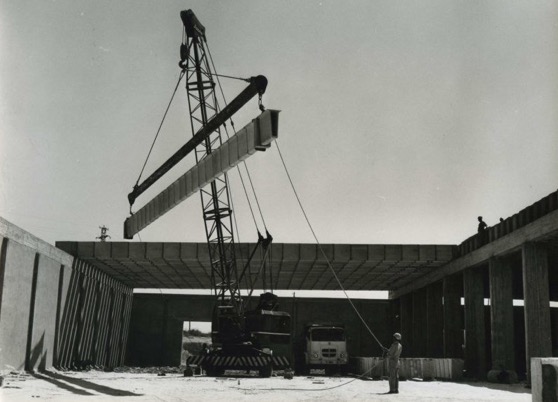
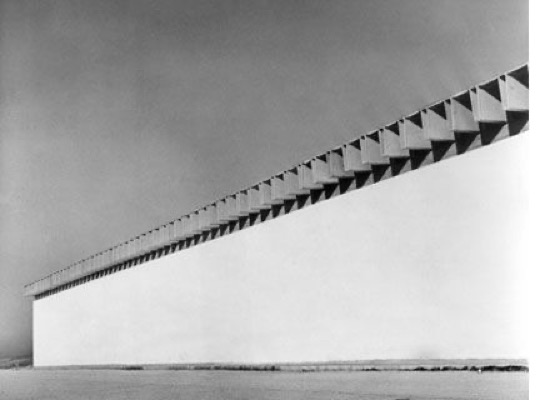
It was a simple design that had no windows but let in air and a little natural light through the separations between beams where they rested on the wall.
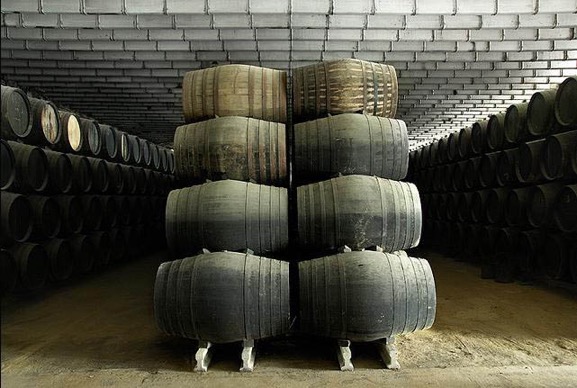
Rumasa took over Garvey in 1978 and expanded it even further during the sherry boom. However in financial difficulties they sold Garvey to a German owner in 1985. In 1997 the Nueva Rumasa bought back Garvey, and merged it with Vinicola Soto, Valdivia, Zoilo Ruiz-Mateos and other companies creating Grupo Garvey in 2000. With Ruiz-Mateos in jail for fraud and Nueva Rumasa under custody, Garvey was sold to yet another shady investor from Valencia who went bankrupt. A lot of its stocks were sold off, but in 2017 the Philippine-owned group Emperador (now Alliance Global Group) bought Garvey, the brandy Fundador from the old Domecq business, and Harveys of Bristol Cream fame. The purchase agreement stated that Emperador would keep the firm alive for at least two years, and as soon as this period expired in 2019 they removed the bottling line and laid off most of the company staff. As far as I know the buildings are still used for storing and ageing of brandy.
In 1973 Bodegas Olarra, in Logroño, La Rioja, built a new winery designed by Juan Antonio Ridruejo (died 2021). The layout was completely different, and in particular it stood out for the set of 111 hexagonal domes that crowned the barrel cellar. A later development was a new visitor centre under the central cupola.
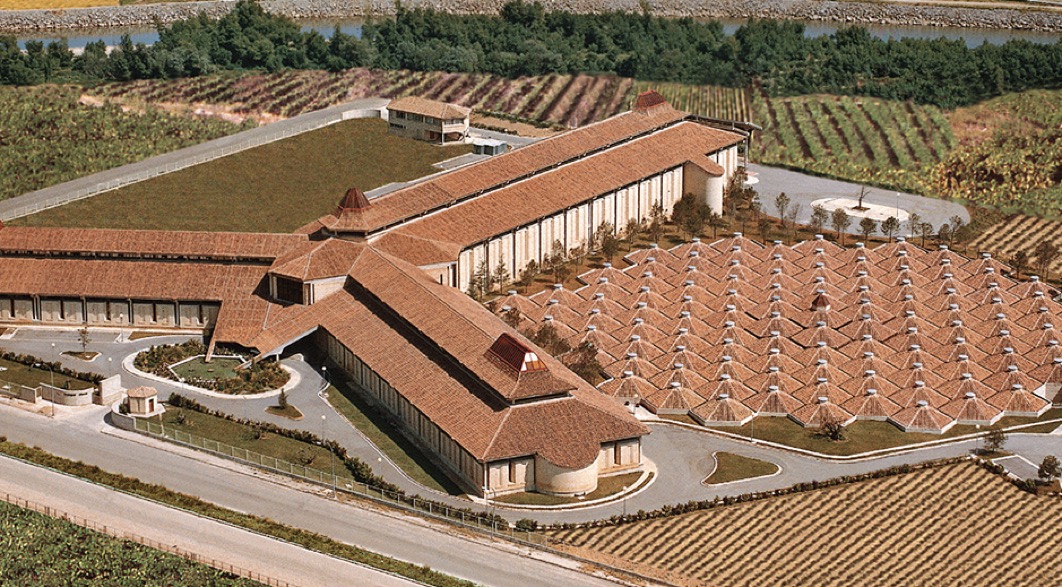
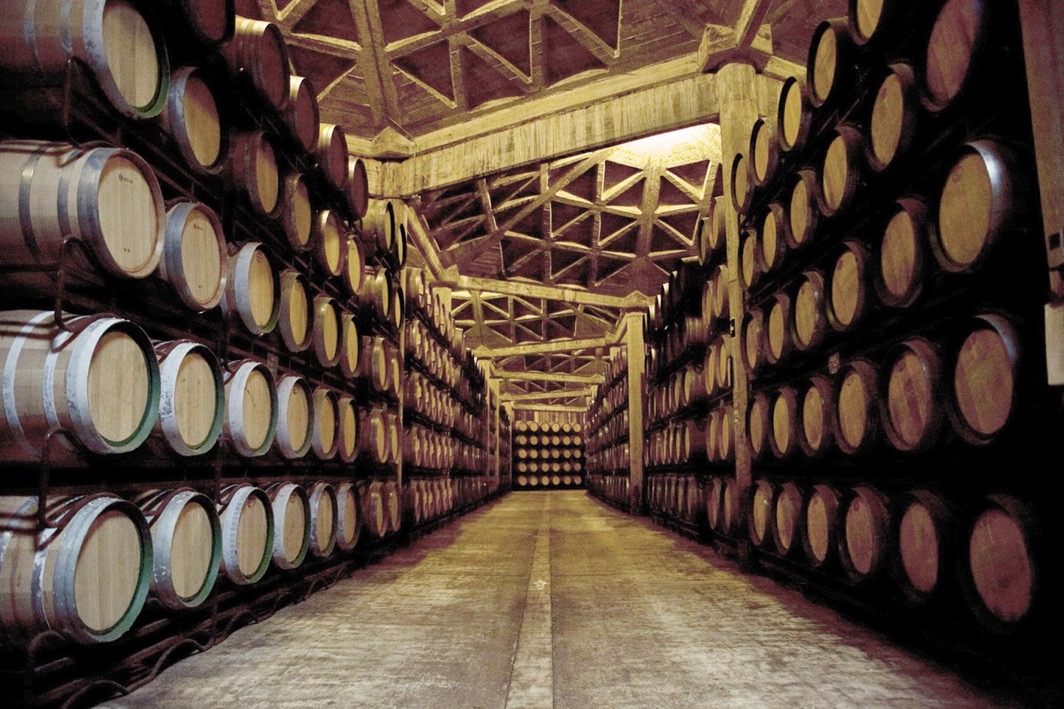
In 1989 Jaume Bach and Gabriel Mora won a prize for the architecture of a new Raventós i Blanc winery. As a commitment to the land and family tradition they built it around an old oak tree. And you can just see in the bottom left-hand corner the old winery, now a Spanish national monument.
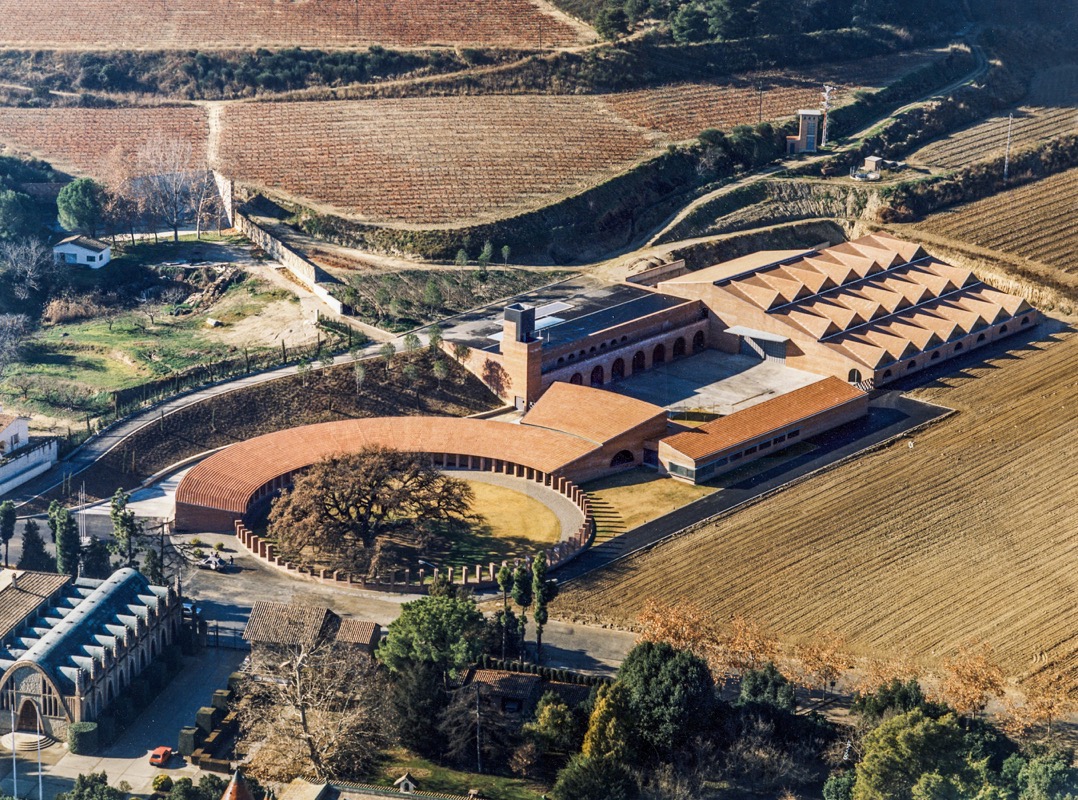
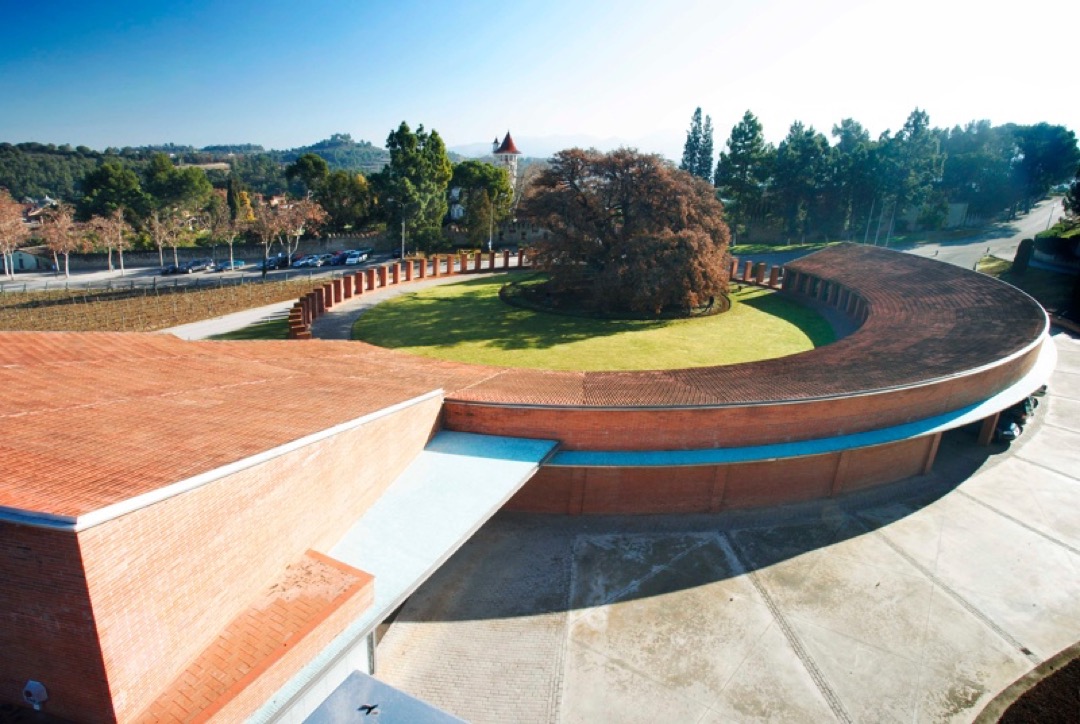
It's interesting because as of 2013, Raventos i Blanc are no longer part of the Cava DO. They created a new, terroir driven appellation, Conca del Riu Anoia, with the idea to set a new standard for high quality wine production, including the use of only indigenous grapes, the practice of ecological viticulture, and accepting only estate produced and estate bottled fruit and a minimum ageing requirement.
Oscar Tusquets Blanca designed the Bodegas Chandon, in Sant Cugat Sesgarrigues, Barcelona. It was inaugurated in 1990 and consisted in a two parallel brick buildings and an underground cellar isolated with a 1-metre deep artificial pond.
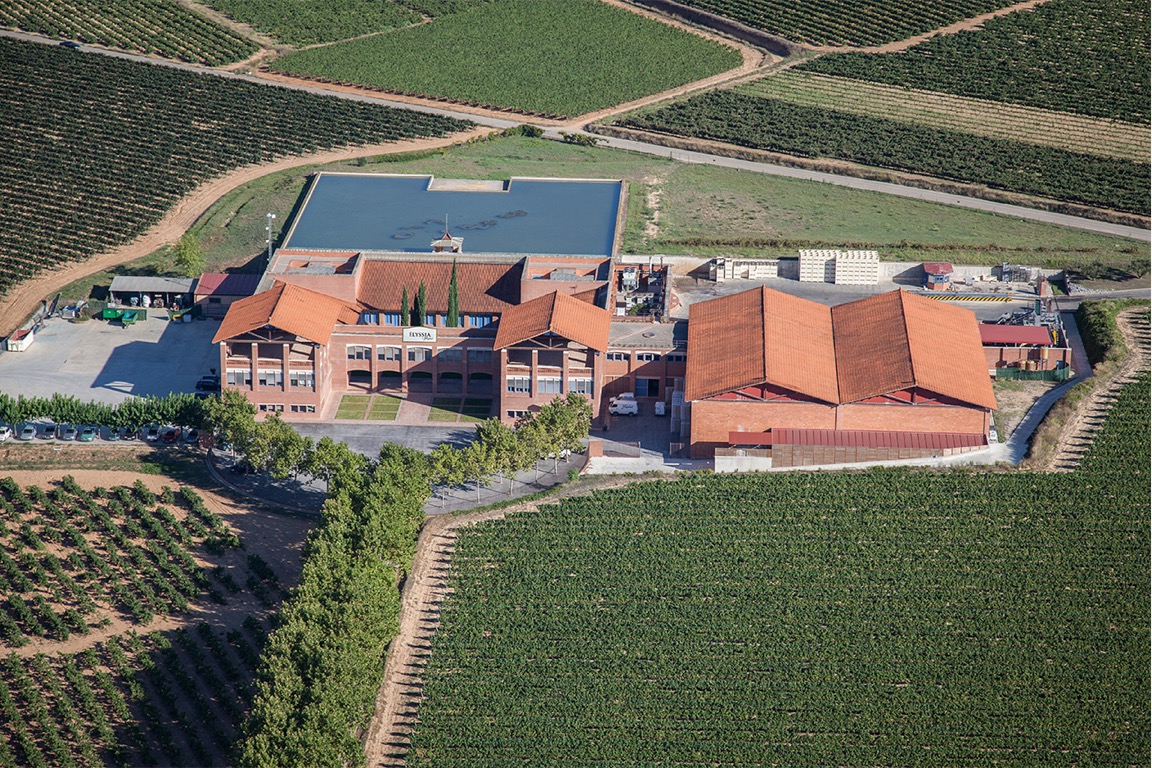
Later it became the Caves René Barbier, but now appears to be Elyssia, part of the Grupo Freixenet.
Bodegas Irache, located in Ayegui, was founded in 1891, although its vineyards already supplied wine to the Royal House of Navarra since the 12th century thanks to the work that the Benedictine monks in the Monastery of Irache. It expanded production in 1918, again 1944, and then in 1970, and now produces more than 10 million litres per year.
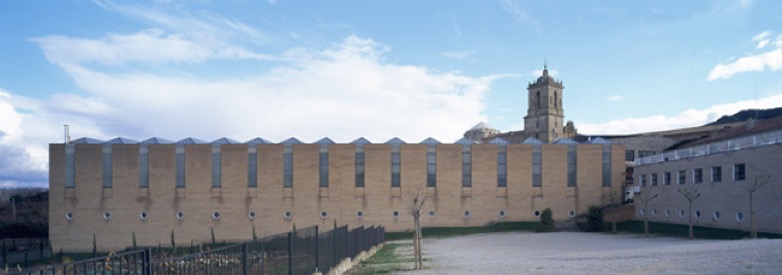
It was in 1991 when the Spanish architect Francisco "Patxi" Mangado completed the new winery of more than 6,000 square metres. The new winery is home to an ageing warehouse for 10,000 barrels, a bottling plant with a throughput of 6,000 bottles/hour, and a store for 3 million bottles. The same architect, Francisco "Patxi" Mangado, would also complete in 1991 the Bodegas Marco Real, a new winery founded in 1989 in Olite.
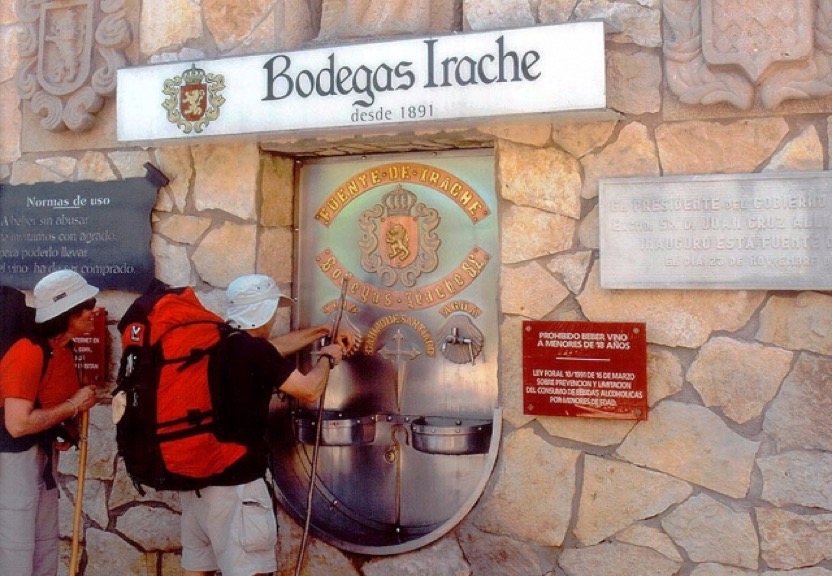
One interesting feature of Bodegas Irache was that the original vineyards were donated to the monastery in 1072 by King Sancho IV. The monastery, which also functioned as a pilgrims' hospital on the Camino de Santiago, was closed in the 19th century, but in 1991 the company built a wine fountain in one of the walls of the winery.
In 1998 the Bodega Otazu in Echauri commissioned the construction of new underground areas for the winery. The challenge was to integrate new fermentation tanks, an ageing area, a bottling and storage area, and a dispatch area, all within a winery that was more than 100 years old.

Particularly impressive is the enormous underground reinforced concrete vaults, home to three thousand barrels.
The Raimat winery is said to be the biggest vineyard in Europe held by a single owner. Today it is a 2,245 hectare organic vineyard located in Raimat, near of Lleida in Catalonia (it is part of the well known Raventós Cordorníu). Manuel Raventós had already established a winery at Sant Sadurní d’Anoia, but in 1914, one year before inaugurating the new Sant Sadurní cellars, he acquired 3,200 hectares of land in Coster del Segre, an area considered infertile. He ordered the construction of 100 kilometres of ditches to irrigate the land with water from the Canal Imperial de Aragón and established a "colonia vitivinícola", a kind of wine village, with 100 houses for the workers and their families, a dozen warehouses, stables for animals, a school and even a church. Today the company owns a multitude of vineyards, harvests about 4,400 tons annually, and produces 15 wines.
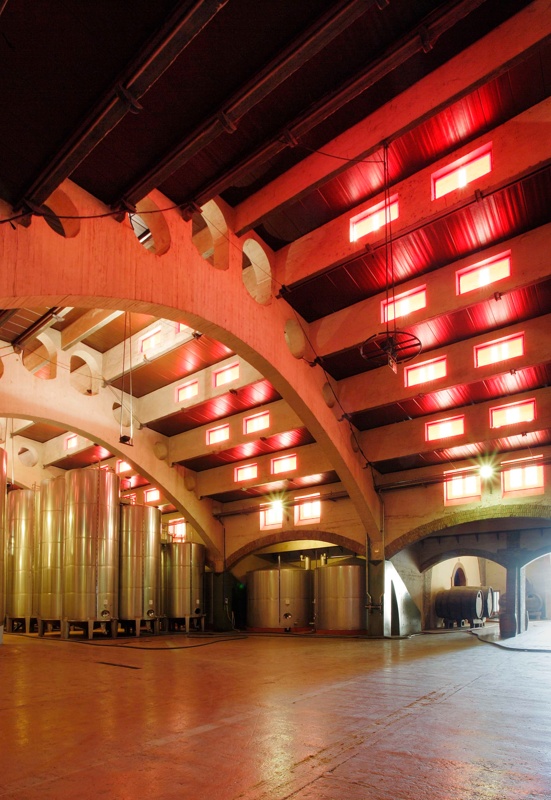
Both the village and the first winery in Raimat were designed by Joan Rubió y Bellver (a disciple of Gaudí) and completed in 1918. It was the first reinforced concrete building to be constructed in Spain, and is often termed the catedral del vino (cathedral of wine).
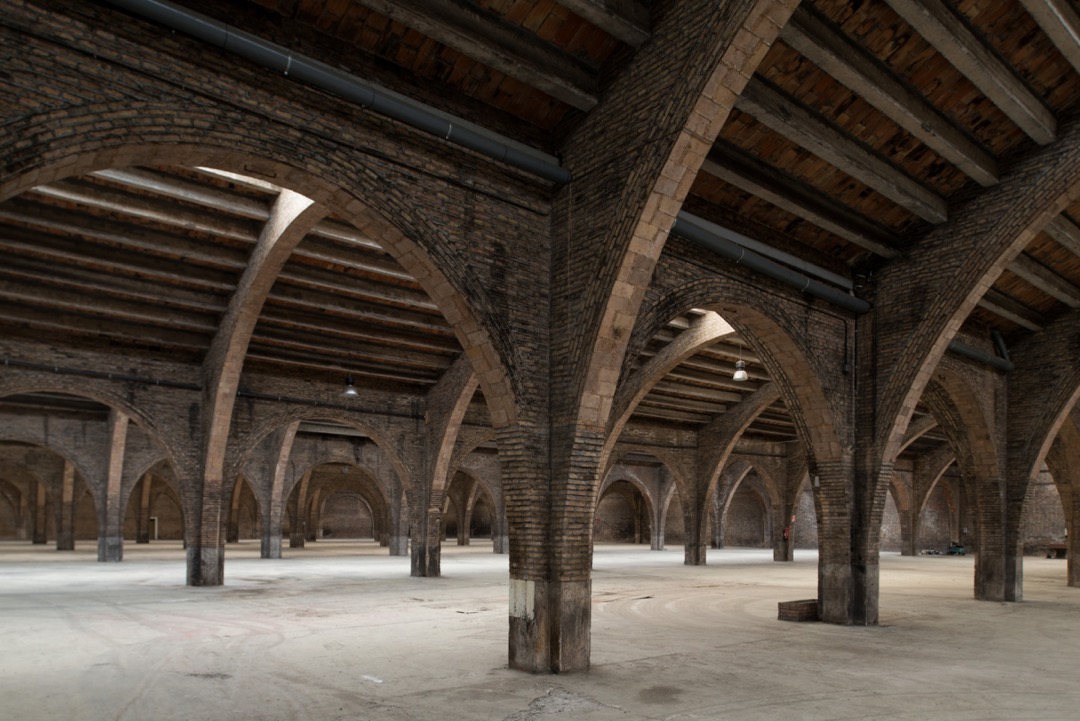
In 1949 the Raventós Codorníu founded the Cava Rondel in Cervelló. The complex dedicated to the production and ageing of sparkling wines included a building designed by the architect Lluís Bonet i Garí, also a disciple of Gaudí. It is worth noting that the property had 8 km of underground tunnels dedicated to the ageing of wines, and at one time produced up to 18 million bottles of cava per year. Today the wine-making activity has been transferred to Sant Sadurní d’Anoia.
Back in Raimat in 1988, they decided to build a new winery. This time, the person in charge of the project was architect Domingo Triay, who ordered the removal of thousands of tons of earth from a hill to build the winery. In this huge underground hollow, they located the ageing warehouses, and on the surface, the rest of the facilities were erected. Then, it was all covered with the same earth that have been removed, so that the hill was rebuilt with its original appearance. The land that covered the winery was planted with Cabernet Sauvignon, one of the winery’s flagship varieties. I've not been able to find out much about this particular construction, except that one report noted that they dug a hole 125 metres long and 90 metres deep, and then covered the final building up again with 1.5 metres of earth. Inside there is an immense concrete vault supported by a steel structure, home to eight 50,000 litre wooden vats, bottling lines and the ageing cellar. From what I can understand, the only things you can see is the concrete and glass entrance (shown below).
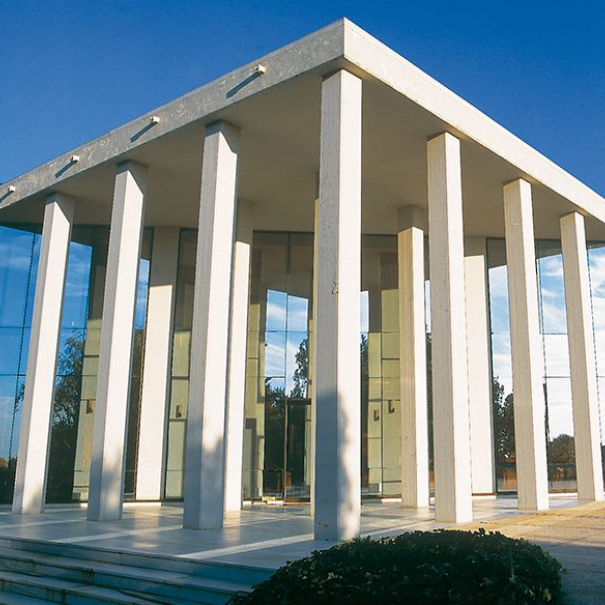
In 1991, the same architect, Domingo Triay, designed another "temple to wine" (see below). But this time it was not in Raimat, but in a hillside in the Napa Valley, i.e. the Artesa winery.
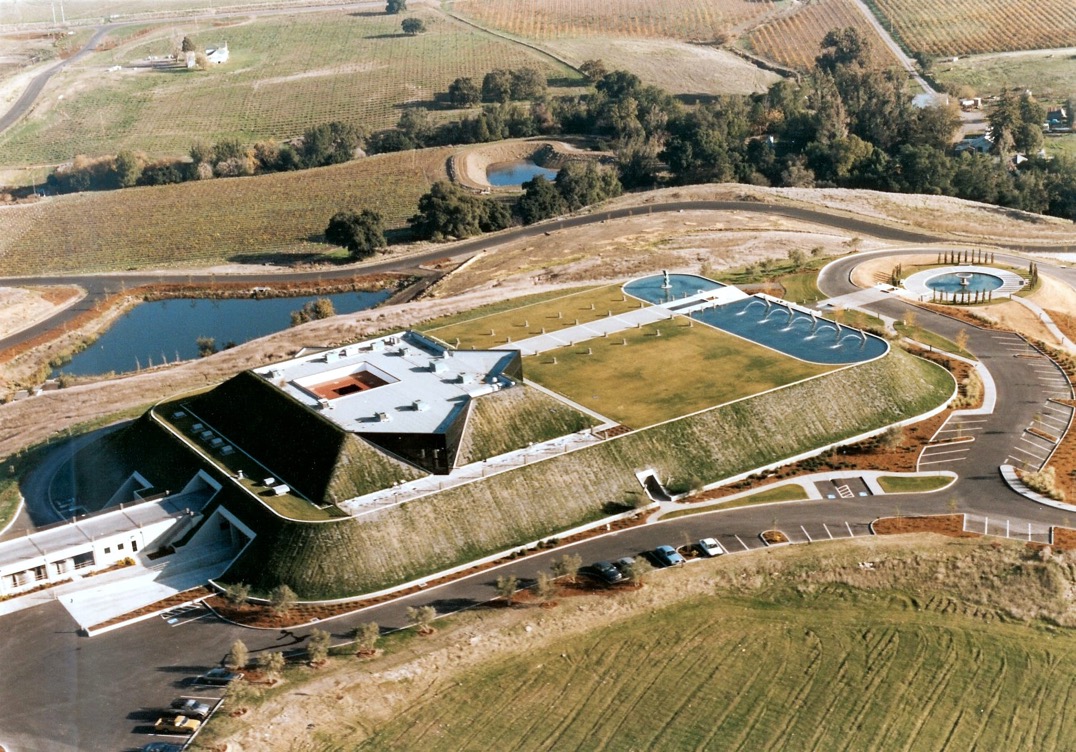
I think in 2019 the US-based Carlyle Group, the world's largest private equity firm, took a majority stake in Codorníu, and has now put the old wineries of Masía Bach and Cavas Rondel up for sale (the two sites have not been active for years).
In 2001 Bodegas Ysios, belonging to the group Domecq Bodegas (and part of the Pernod Ricard), inaugurated a Santiago Calatrava designed winery in Rioja Alavesa. They wanted an iconic building that would attract attention to the Alavesa wine region and at the same time provide the space needed to make, store and sell wine. The building is almost 200 metres long, and covers 8,000 square metres. It is "just" two reinforced concrete walls separated by 26 meters and clad with copper-treated wooden slats arranged vertically, but what is unique is the wavy roof design.
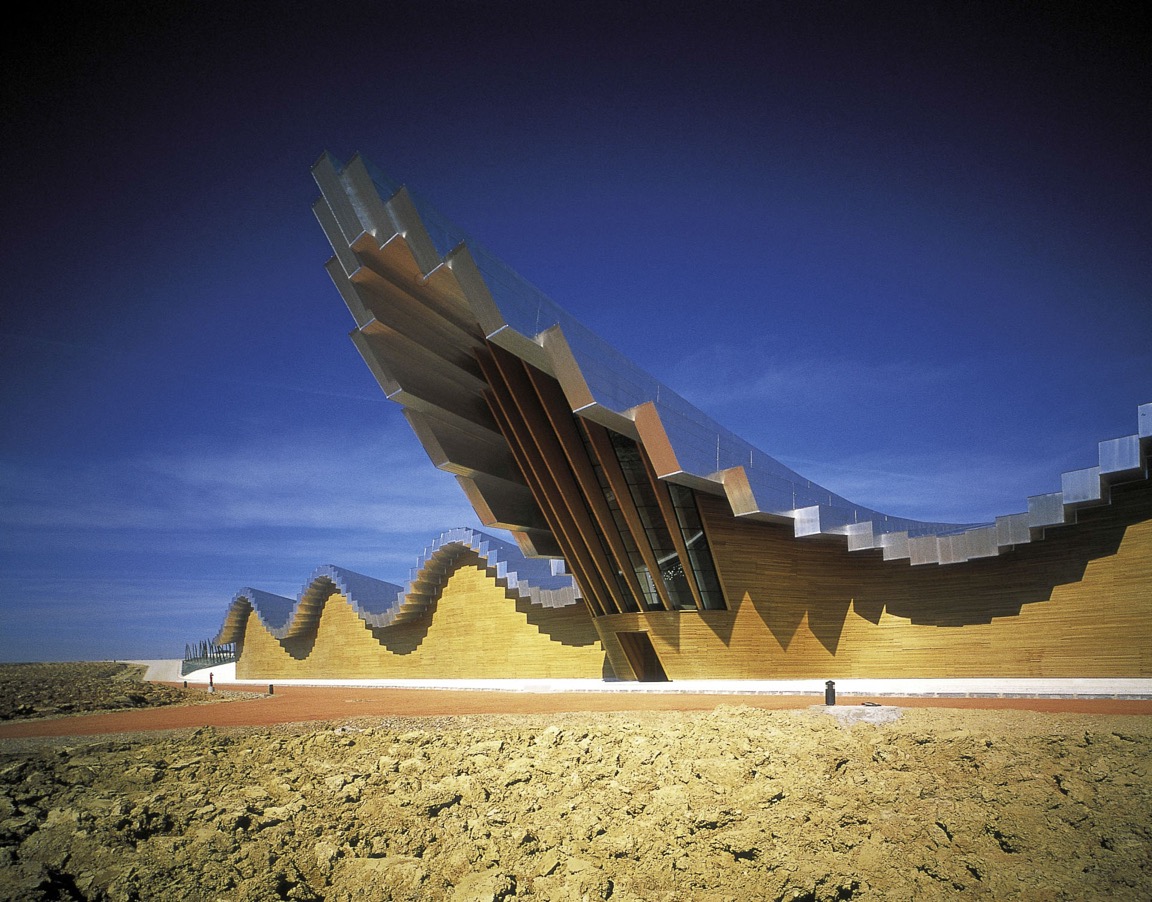
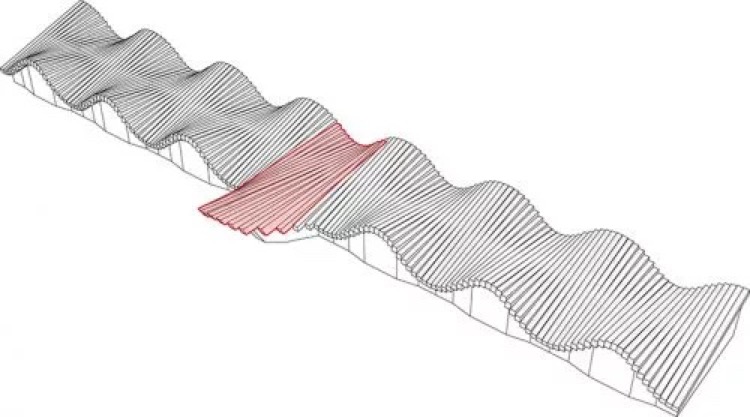
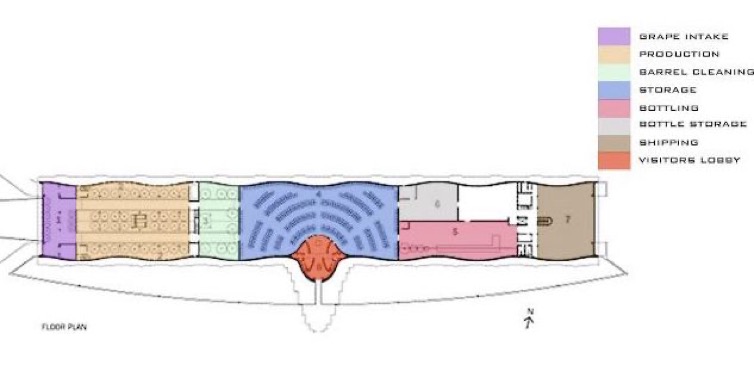
It's more or less a linear run, with grapes entering at one end, and bottling and shipping at the other end.
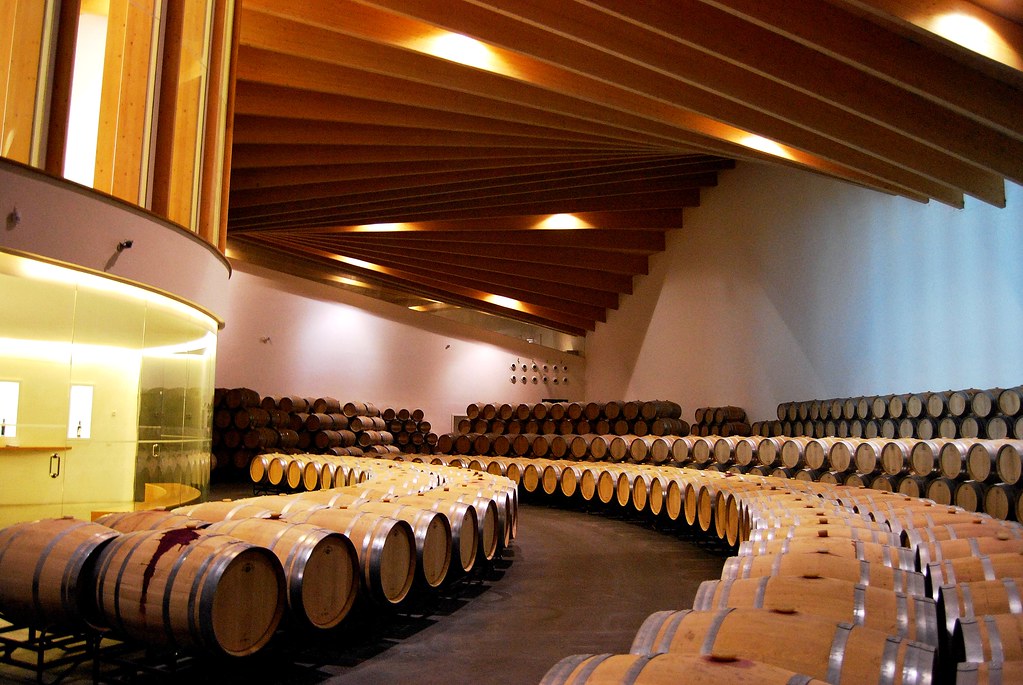
The total cost of the work was about € 15 million, of which only € 3 million was for the wine making equipment. However, in 2013 a € 2 million lawsuit was filed against the architect and construction company because the aluminium and cedar roof sheets moved with the wind and let in rain.
In 1988, the Chivite family bought a 300-hectares estate known as Señorío de Arínzano, located in the municipality of Aberín. The story goes that the Chivite family had been producing wine since 1647, but with the recent financial crisis the new owners were forced to restructure their debt to avoid bankruptcy, and so they sold-off Arínzano. The Arínzano estate had once produce wine (possibly as early as 1055), and the new owners went to work to plant new vineyards.
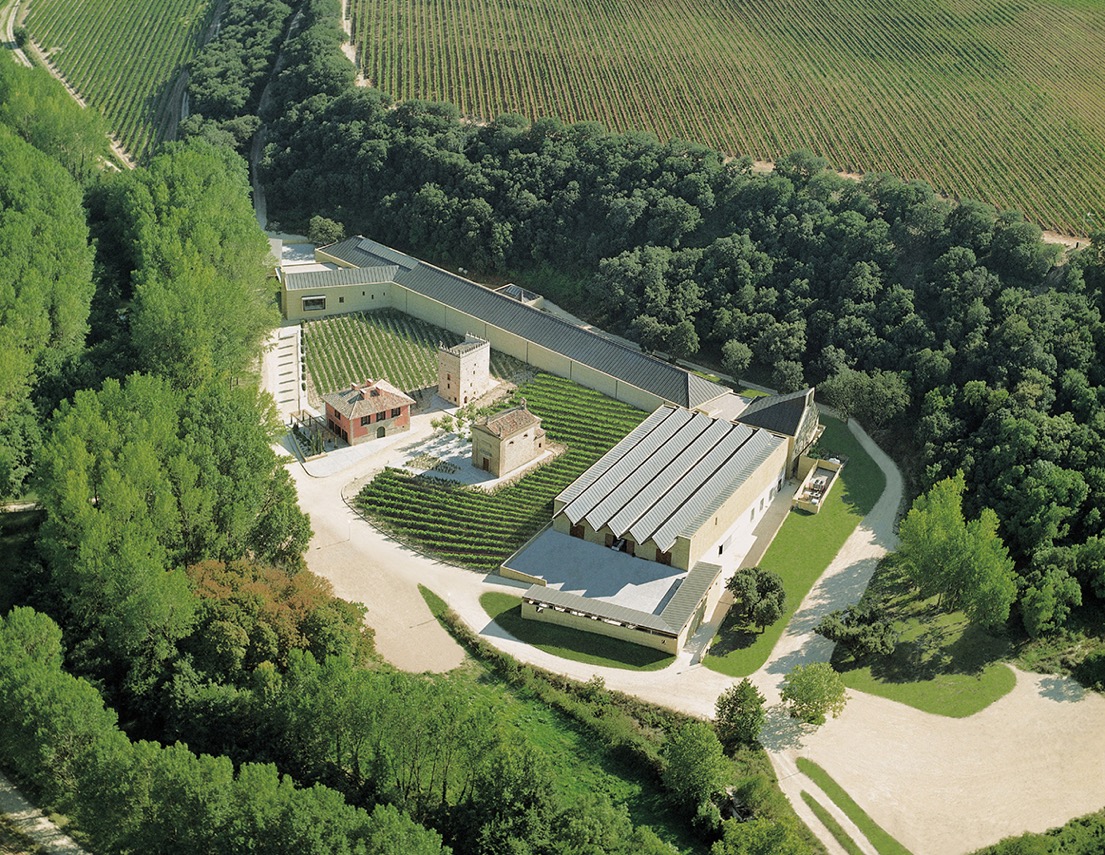
Building around a 16th century tower, an 18th main building, and a 19th century church, the owners constructed a new winery to produce 225,000 bottles annually. The Spanish architect Rafael Moneo designed the industrial plant to include all the essential processes in wine making, i.e. a closed grape reception yard surrounded by a quadrangular of five halls, including a hall for forty 22,000 litre fermentation tanks, a partially buried 100-metres long hall for the ageing of the casks, and a free-standing building for bottling, storage and tasting.
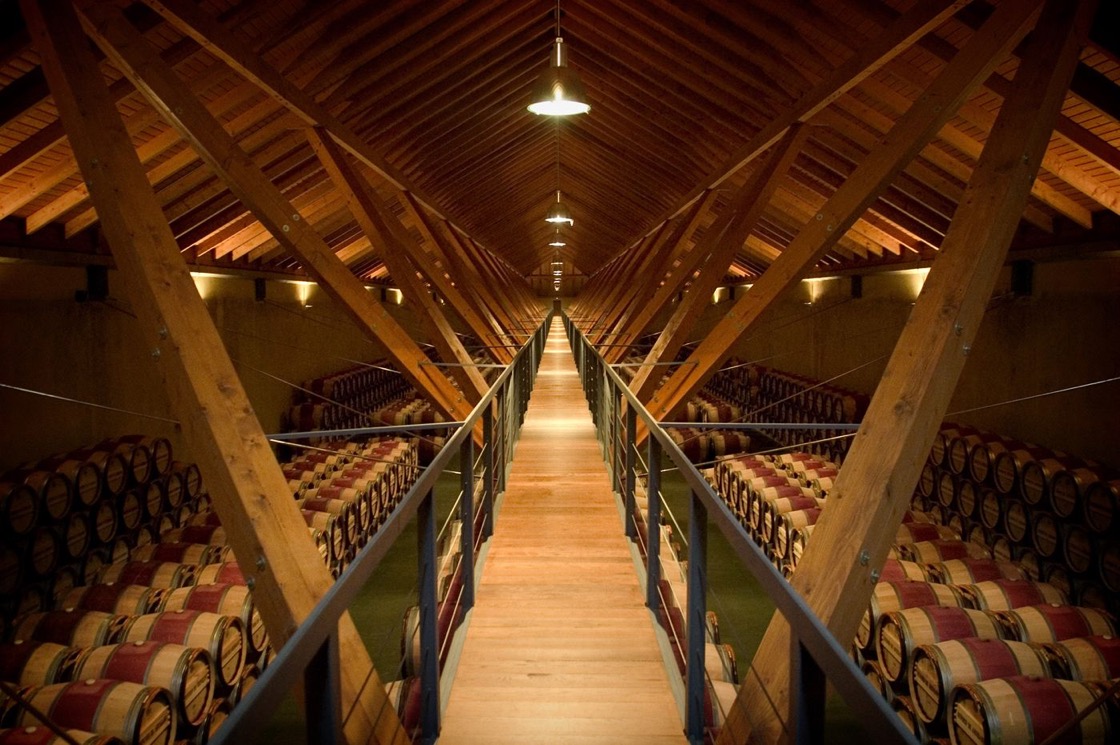
He restored the old buildings and integrated the new buildings into the local environment using sand-blasted concrete walls and copper roofs. The buildings were completed in March 2002. One little known feature of this particular estate is that of the 355 hectares of the property, 128 are dedicated to the cultivation of so-called Vino de Pago, a new higher level classification than just the Denominación de Origen Protegida (DOP) or Denominación de Origen Calificada (DOCa).
In 2002 the Bodegas Baigorri, designed by Iñaki Aspiazu (died 2014), was inaugurated in Samaniego, Álava. The winery covers 14,000 square metres and cost more than € 7 million.
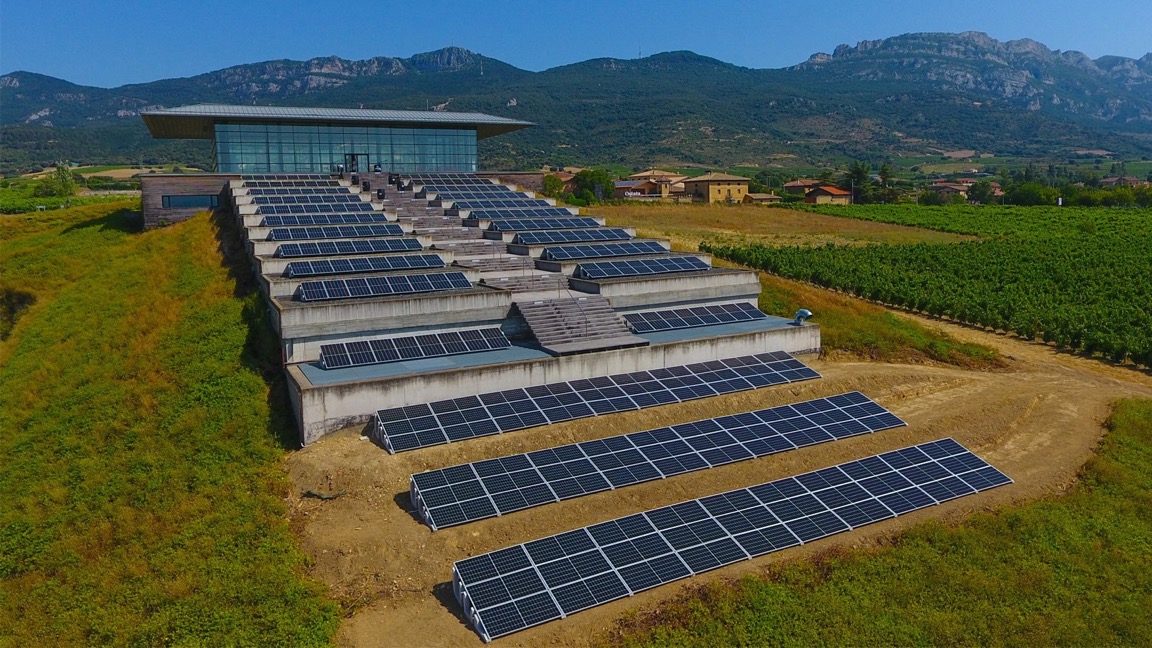
Most of winemaking process takes place underground and it is entirely carried out by gravity in order to preserve the integrity of the grapes as much as possible so that they can reach the fermentation tanks in one piece.

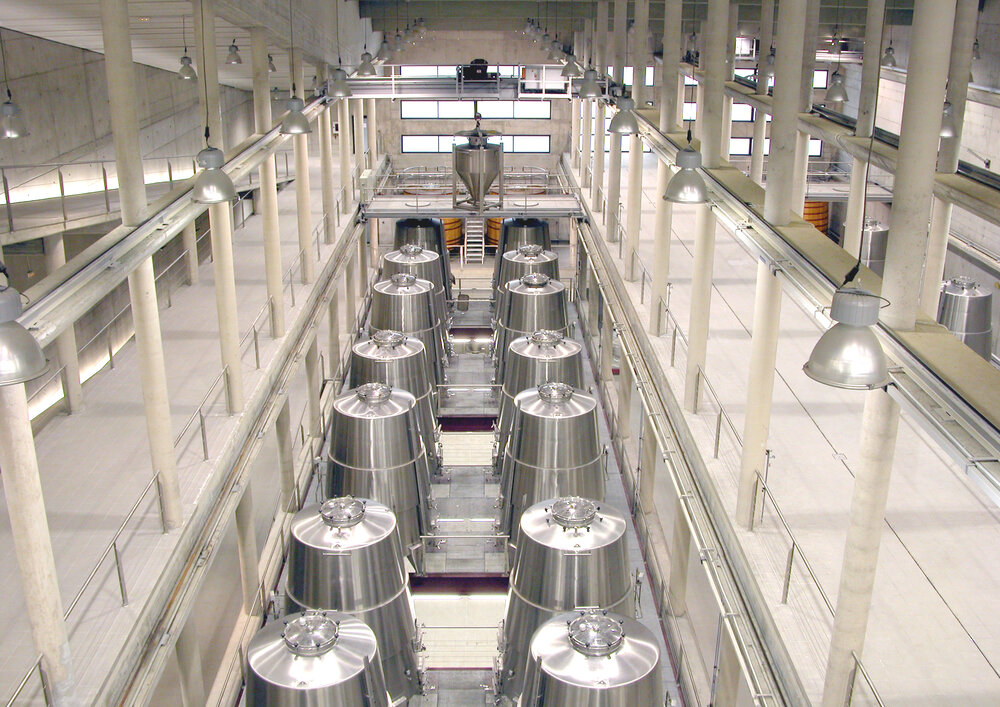
There is no reception hopper and no pumps are used to transfer the juice from one tank to another. What is amazing is that a modern winery looks like a large chemical plant.
Many of the vineyards and architects clearly try or avoid an overt dramatic visual impact, but Bodegas López de Heredia decided to treat itself to an "architectural luxury", and Zaha Hadid was happy to oblige.
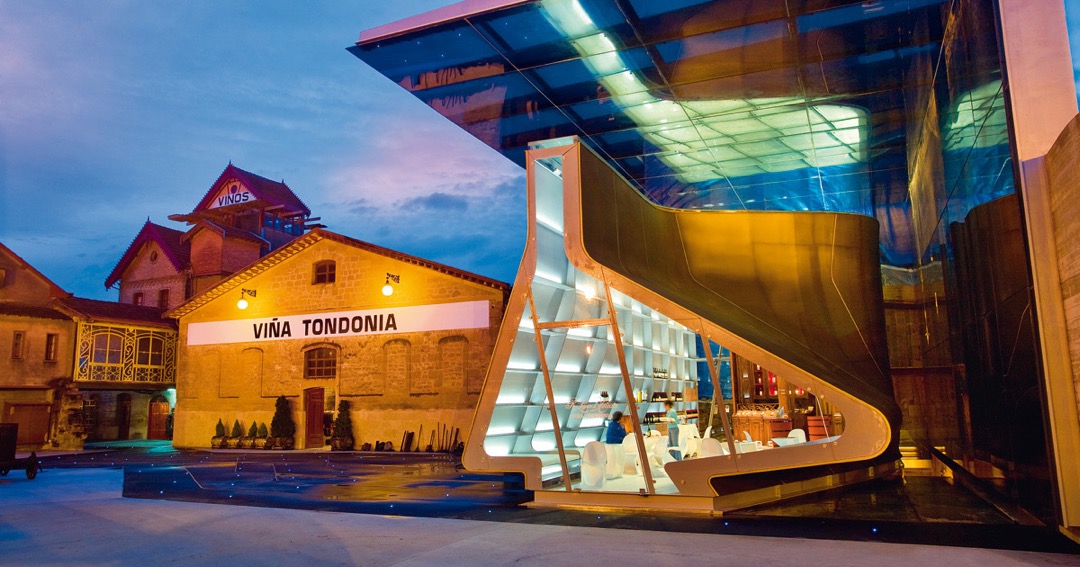
In 2002 the bodega decided to renovate the old store they took to the 1910 Brussel's World Fair (it was considered modernist at the time), but they needed to build an exterior volume to house the old store.
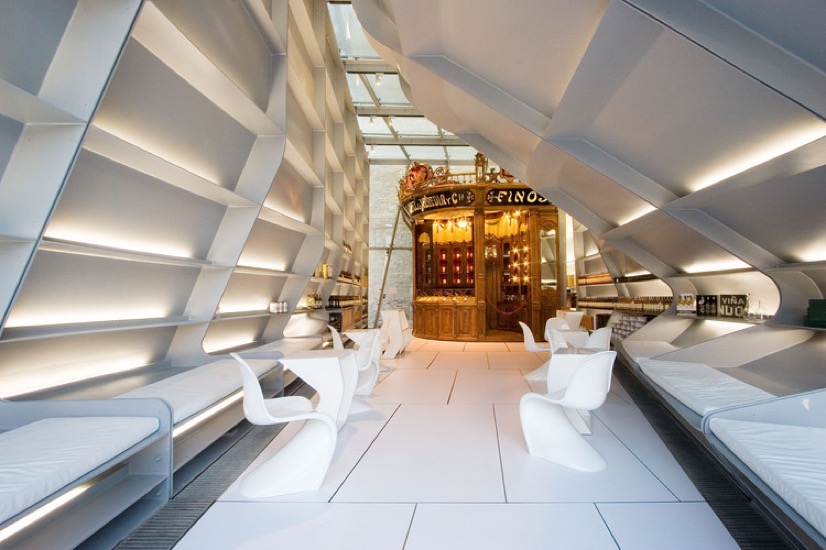
Various studies for housing the old store led to "a new bottle for an old wine", and finally to the form of a decanter.
In 2002 a new 66-hectare Bodegas Darien in Logroño, La Rioja, was inaugurated. The winery was designed by Jesús Marino Pascual, and was envisaged to age 1,750 barrels and produce 2 million bottles a year.
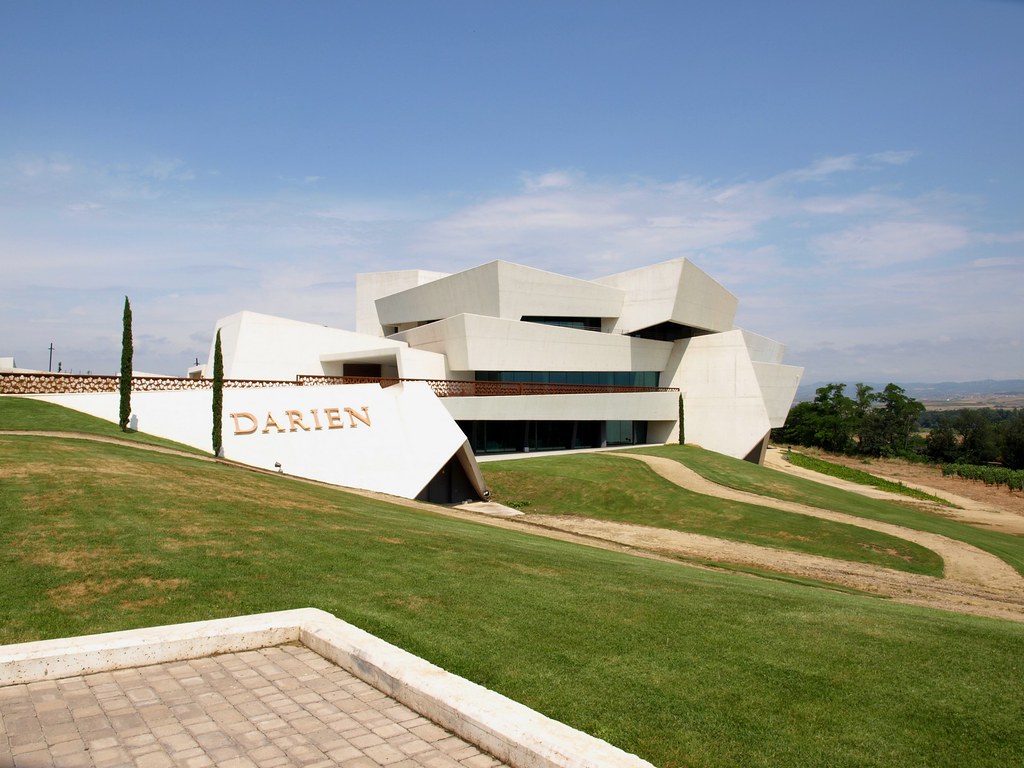
It is my understanding that in May 2020 Bodegas Darien was declared bankrupt and was extinguished as a legal entity.
The Bodegas Habla, in Trujillo, Cáceres, was established in 2002. I like the names that have been given to the wines, i.e. the most popular is Habla del Silencio, then there is Habla de la Tierra, and finally there is a white wine called Habla de Ti.
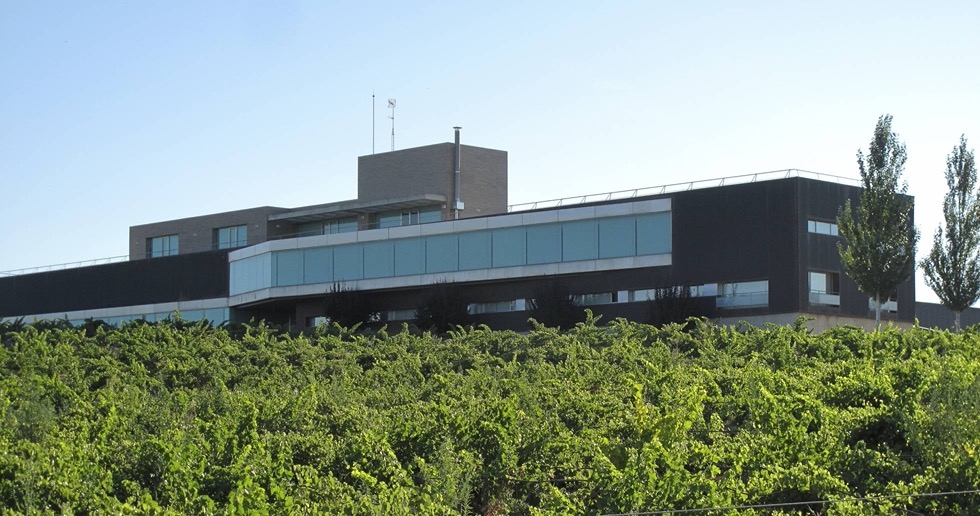
The architect was Daniel Juménez Ferrera, who won an award for the design of this building. It's interesting that initially the 200 hectares were divided into 64 plots so as to study the varieties of grapes that would best adapt to the environment. In addition they were one of only a few vineyards that did not want to be within any "DO" denominación de origen (not from the Ribera del Guadiana), which is usually a guarantee of more sales. This allows the owners to age the wine in barrel for as long as they need and not as required by a DO, in fact, moving away from standardisation has been one of the pillars of the project.
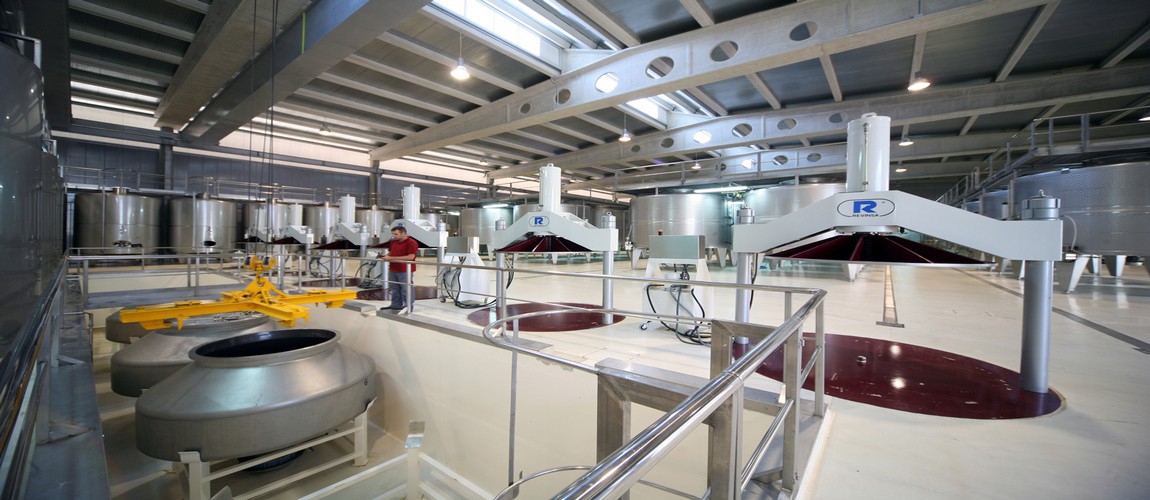
Problems that had to overcome were the poor and acidic soils, a high phytotoxicity, extreme climate and little water for irrigation. In the end, the choice of exclusive clones from the Bordeaux area, in France, could not have been more successful (six reds and one white). They were the first Spanish winery to launch three wines with a single grape variety, Cabernet Sauvignon, Tempranillo and Syrah, in 2005 (Speaks number 1, Speak number 2 and Speak number 3). The grapes are harvested by hand and no chemicals are used, the winery covers 15,000 square metres, and no pumps are used, only gravity.
Bodegas Campo Viejo, owned by Pernod Ricard, is located near Logroño, La Rioja, and consists of 37 hectares of undulating vineyards and a 45,000 square metres winery. It was designed by Ignacio Quemada and inaugurated in 2003.
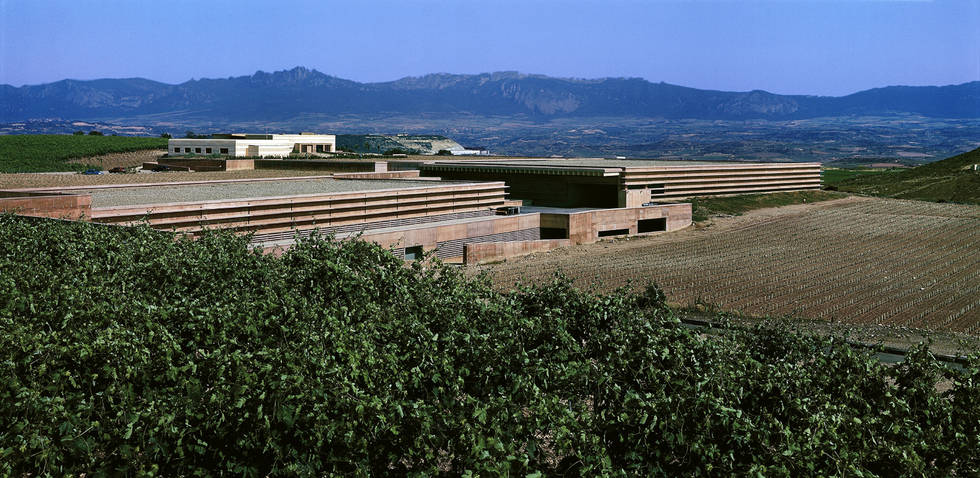
The buried cellar is organised into two volumes with two floors, the 15,000 square metres warehouse for elaboration and tank storage, (heigh 16 m), and a second rectangular volume of 12,000 square metres for barrel ageing (height 7 m), and then bottle ageing, packaging and warehousing.
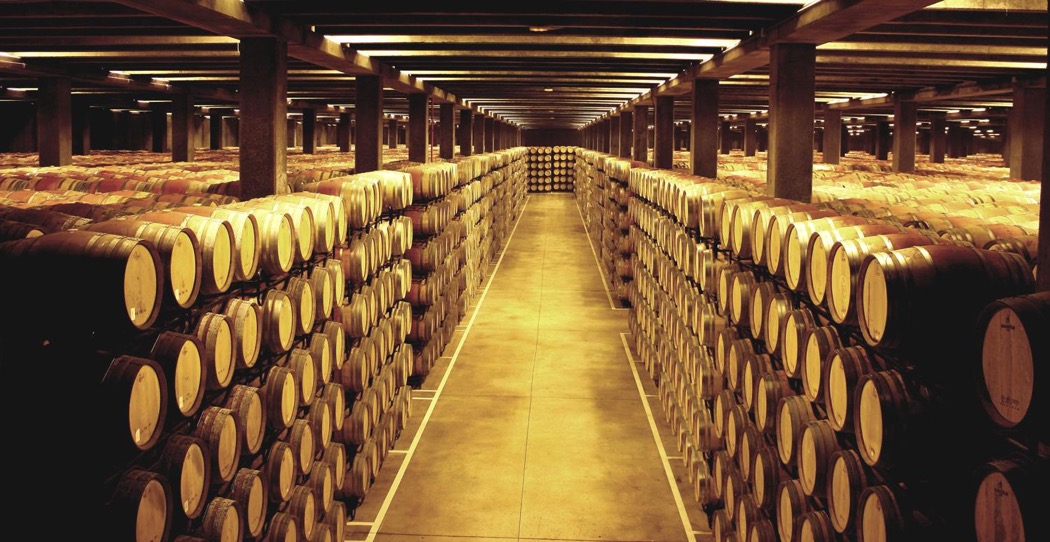
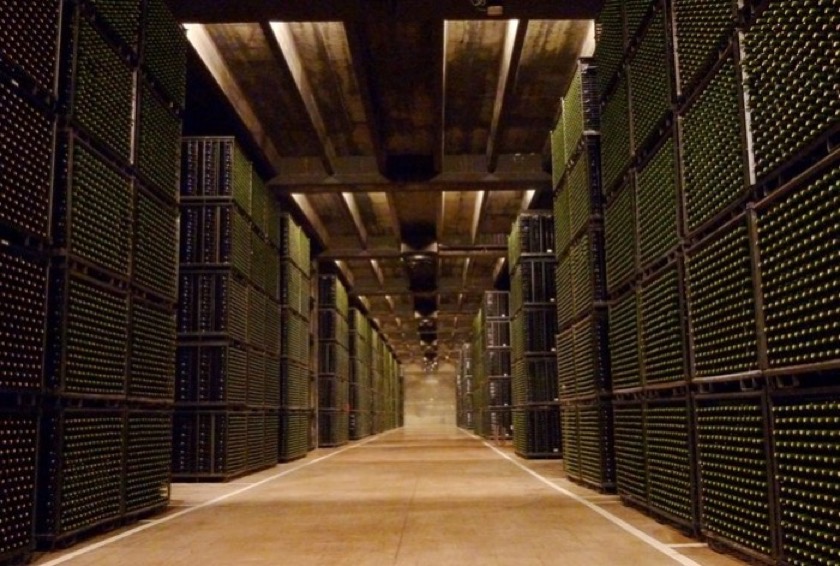
Thy claim to have one of the most impressive barrel and bottle stores in Spain.
In 1879 the Compañía Vinícola del Norte del España (the Northern Spanish Wine Company, or the CVNE - often seen as CUNE), was founded in the town of Haro, La Rioja. In 1909 the famous French architect, Alexandre Gustave Eiffel, designed a truly revolutionary cellar, without columns, the roof was supported by steel trusses, and ran from wall to wall. This created a large open space that significantly improved the management of barrels in the cellar, make racking, maintenance, and monitoring of the wine barrels much easier. In 1940, the same company, would inauguration “El Carmen”, the first winemaking facility built using epoxy lined concrete, and in 1989 they would build “El Pilar”, the first winery to use gravity in the fermentation process. In 2004 they opened a new winery for Viña Real, designed by the French architect Philippe Mazières. It was probably the most advanced winery built in Spain at that time.
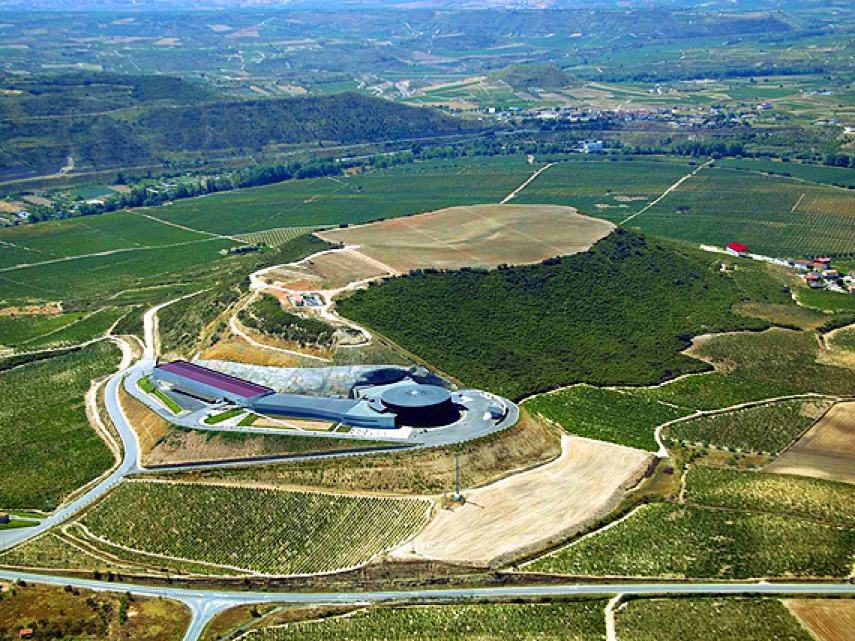
The winery consists of a gigantic circular building made of Canadian red cedar wood (and resembling a barrel cut in half), and two colossal tunnels drilled into the side of a hill.
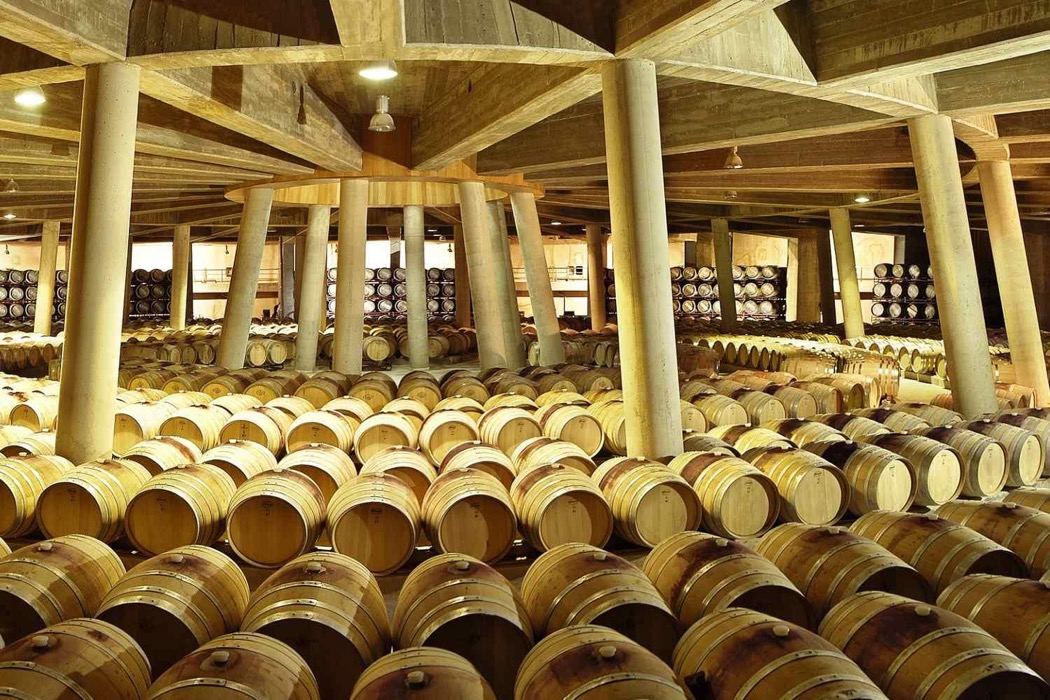
The circular central building houses two floors of fermentation tanks sitting above a barrel room. However, most of the barrels are stored in the huge tunnels drilled into the mountain. There are two, identical, tunnels 15 meters high and 125 meters long, and they are joined by a passageway providing a vent to the top of the mountain. One tunnel contains 14,000 barrels stacked eight high, and the other, 6,000 barrels and tens of thousands of bottles in metal cages (see this description).
In 2006 a new winery Bodega Marqués de Terán in Ollauri, La Rioja, was inaugurated. Designed by MRM Arquitectos it exploited the local sloping terrain to firstly provided for the arrival and movement of the grapes by gravity, and secondly to include a semi-buried cellar.
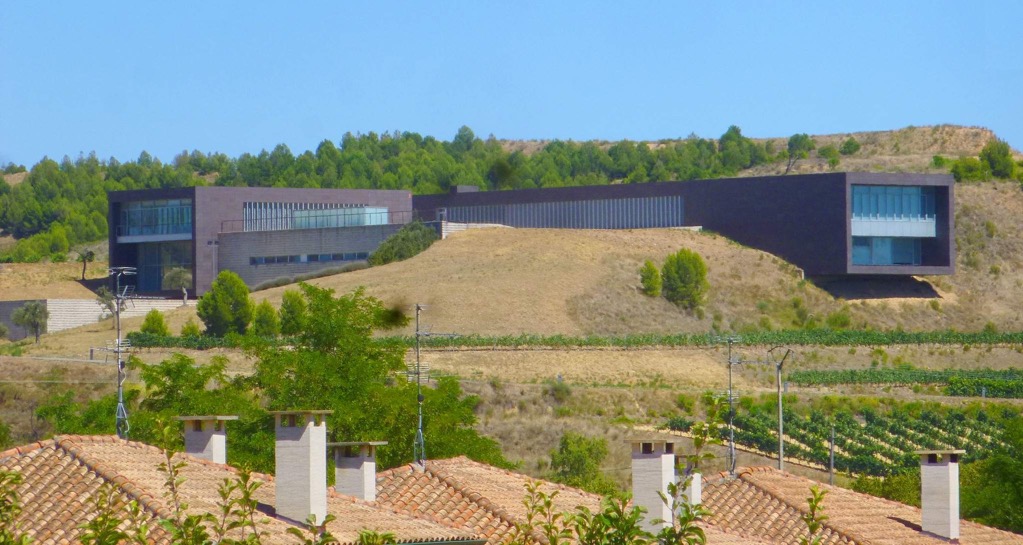
The bodega presents itself as a concrete base topped with two pieces of burgundy quartzite. The interior is designed to allow the visitor to tour the entire winery following the route that the grape takes from entry to bottle.
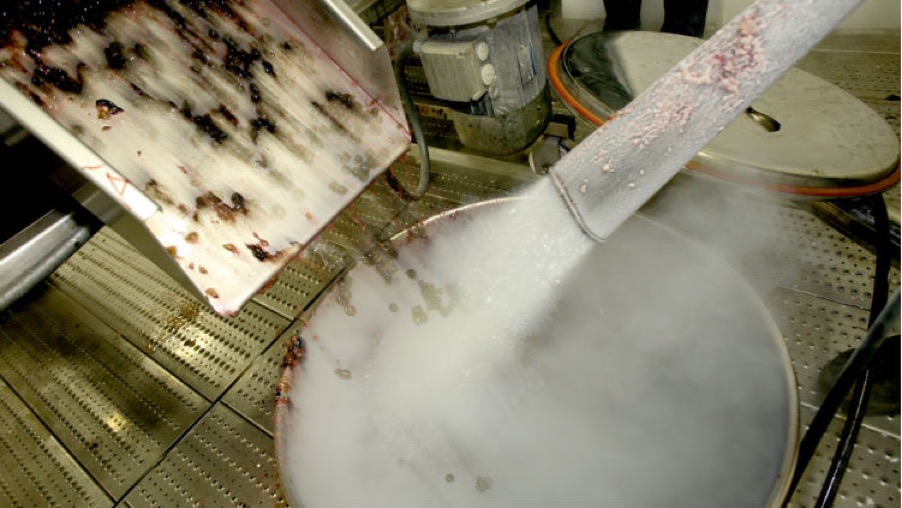
One unusual feature of Bodegas Marqués de Terán is that it uses cryomaceration, a technique applied mainly in the vinification of whites, for the production of all its red wines. Cryomaceration consists of lowering the temperature of the freshly crushed and de-stemmed grapes to increase the colour and aromas of the must, without extracting too much astringency as there is no alcohol, just fresh grapes. The idea is that this 100% natural technique allows them to create wines with more structure and body right from the beginning of their life.
Grapes are instantly chilled to 5°C on arrival by adding carbon-dioxide. The stainless-steel fermentation tanks are equipped with an innovative system that guarantees a smooth and gentle movement of the mass inside the tanks. The idea is to maintain the temperature throughout the deposit at between 5 °C and 8 °C during a period from 3 to 8 days, thus extracting the maximum colour, aroma and essence of the fruit prior to fermentation.
Bodegas Cepa 21, is a new winery in Castrillo de Duero, and another project of José and Javier Moro, sons of Emilio Moro. Inaugurated in 2007, it was designed by Alberto Sainz de Aja and José Manuel Barrio, from the firm BSA Proyecta, and the total investment was € 12 million.
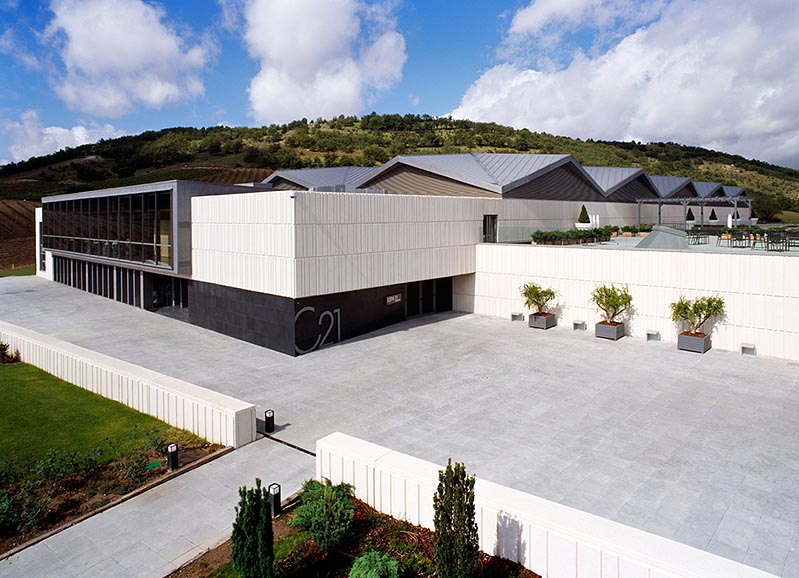
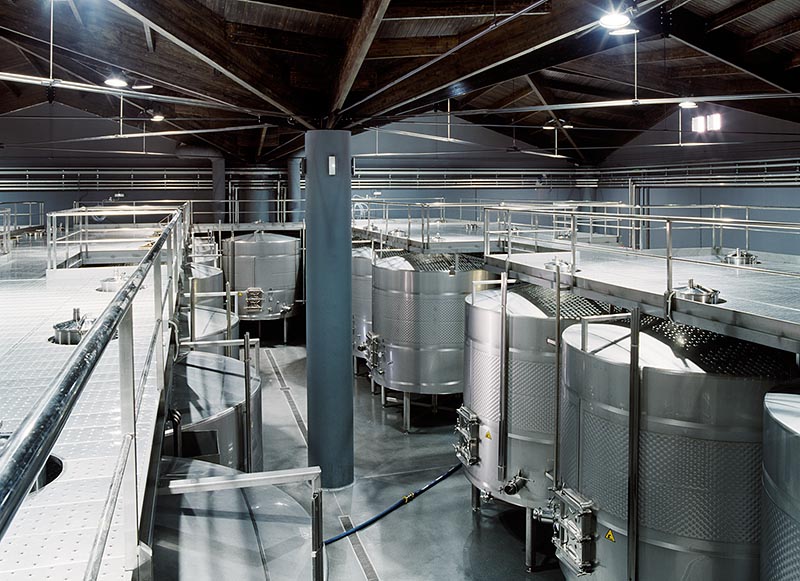
The origin of the winery dates back to 1891, the year its founder, Emilio Moro, was born in Pesquera de Duero, a privileged enclave in the Ribera de Duero surrounded by vineyards. Emilio Moro, grandfather of the current owners, imparted to his son the love of winemaking, and he in turn passed it on to his children.
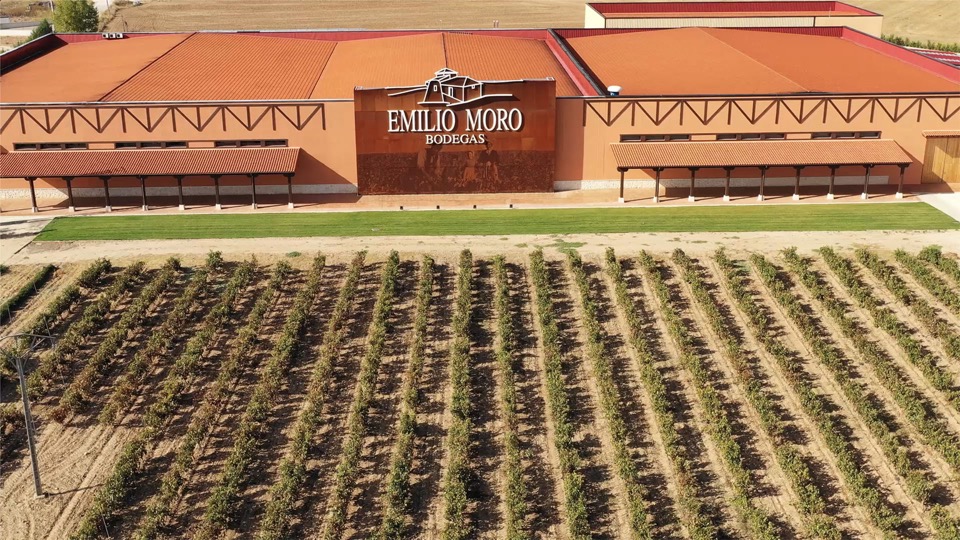
Three generations later, José and Javier Moro take care of the winery that currently owns 200 hectares of its own vineyards, planted and grafted with an excellent tempranillo clone recovered from their oldest vines.
In 2008 a new winery opened, in Barbastro, province of Huesca, a very impressive and futuristic building designed by Jesús Marino Pascual. Originally known as Bodega Irius it was acquired in 2014 and re-named Bodega Sommos. The winery produces a Somontano wine production, the youngest denomination in Spain. Originally it was 100-hectare property with a production capacity of 5.5 million litres, exporting nearly 70% outside Spain.
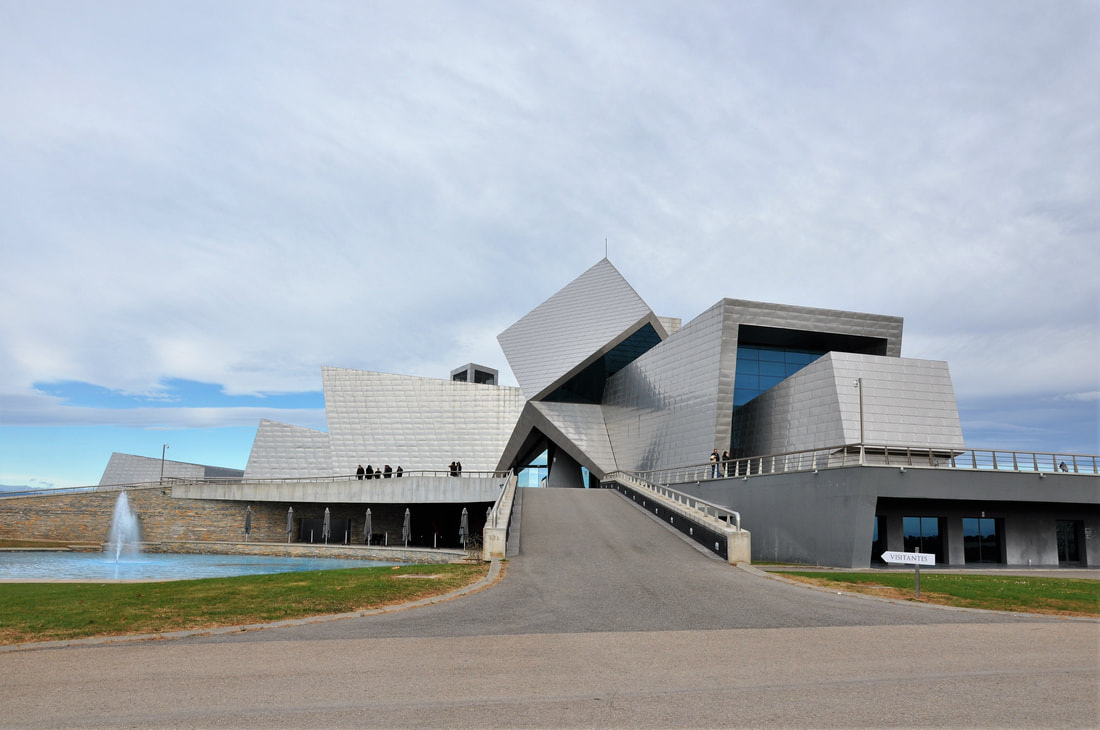
Sitting in the middle of 350 hectares of vines is 23,000 square metres in the form of cubes, one of which is 50 metres high (27 metres underground), the total having cost € 90 million.
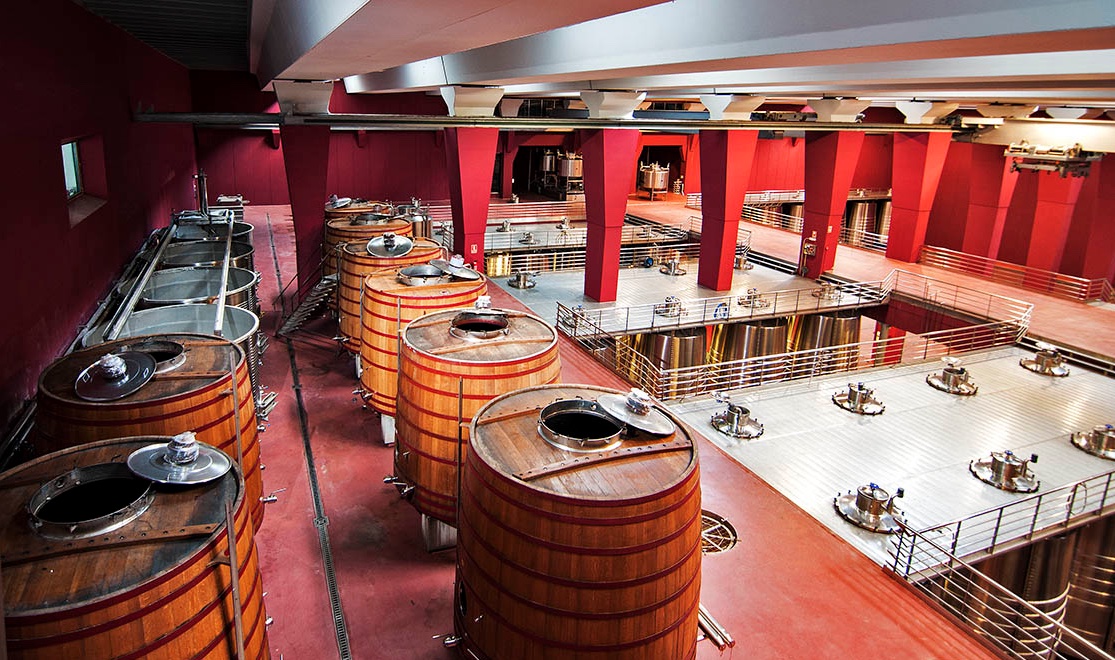
Designed as a so-called bioclimatic building, it consumes 50% less energy that a grand-level warehouse. Interestingly they have an experimental vineyard for testing 23 white and 50 red varieties, and equally they have frustoconical tanks (i.e. truncated cone), open stainless steel presses, concrete tanks, and wooden vats.
In 2008 a new 66-hectare Bodegas Antión in Logroño, La Rioja, was inaugurated. The winery, designed by Jesús Marino Pascual, had a unique architecture, said to have been inspired by a vine. It was a 100-hectare vineyard, and was projected to produce 200,000 bottles per year, mostly for the export market.
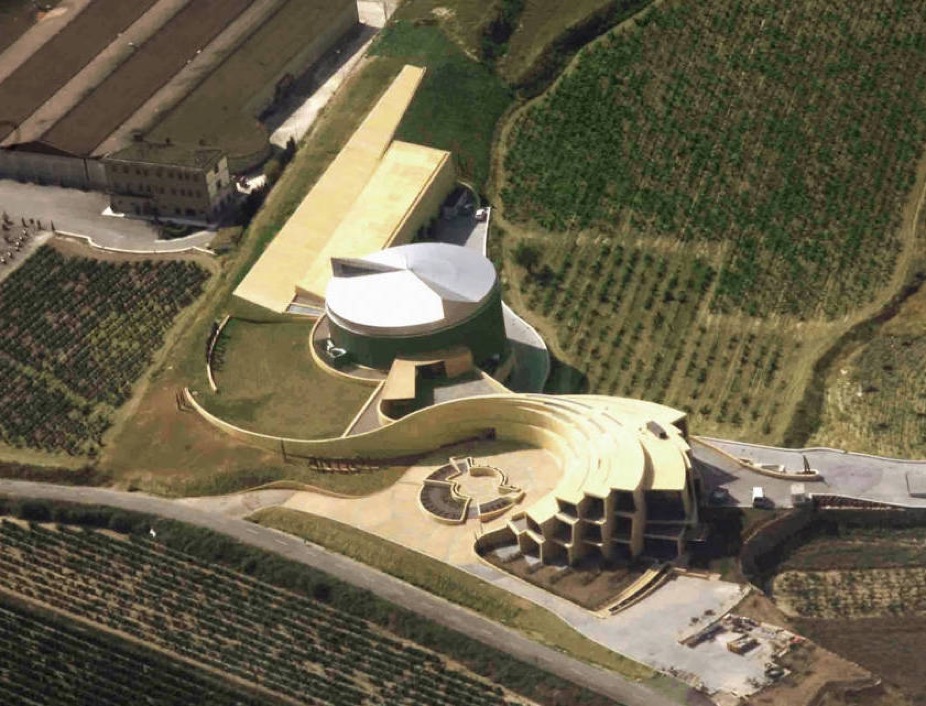
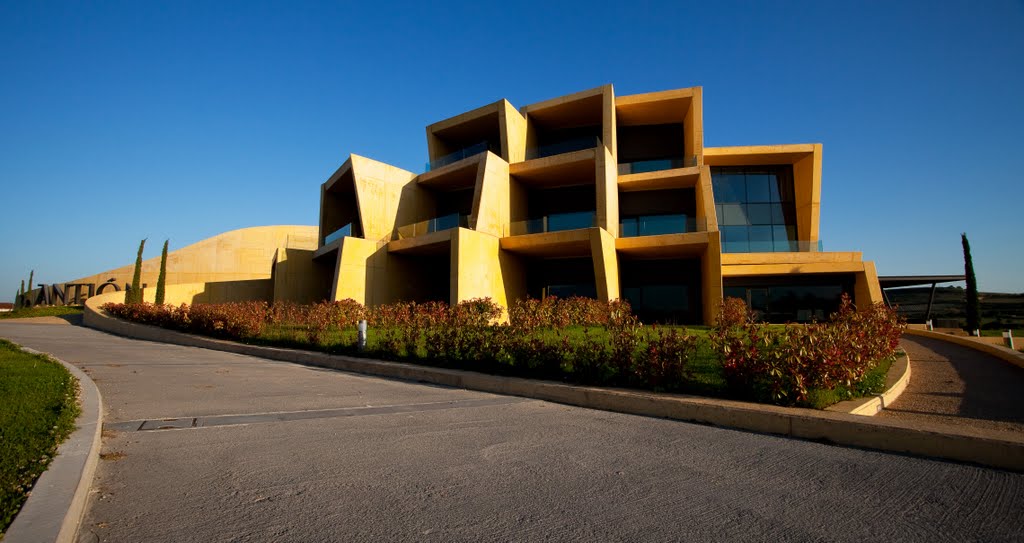
The nucleus of the winery was a processing hall in the form of a 30 metres tall. The outer walls of this area were surrounded by the halls housing the casks, the building material was a coloured cement.
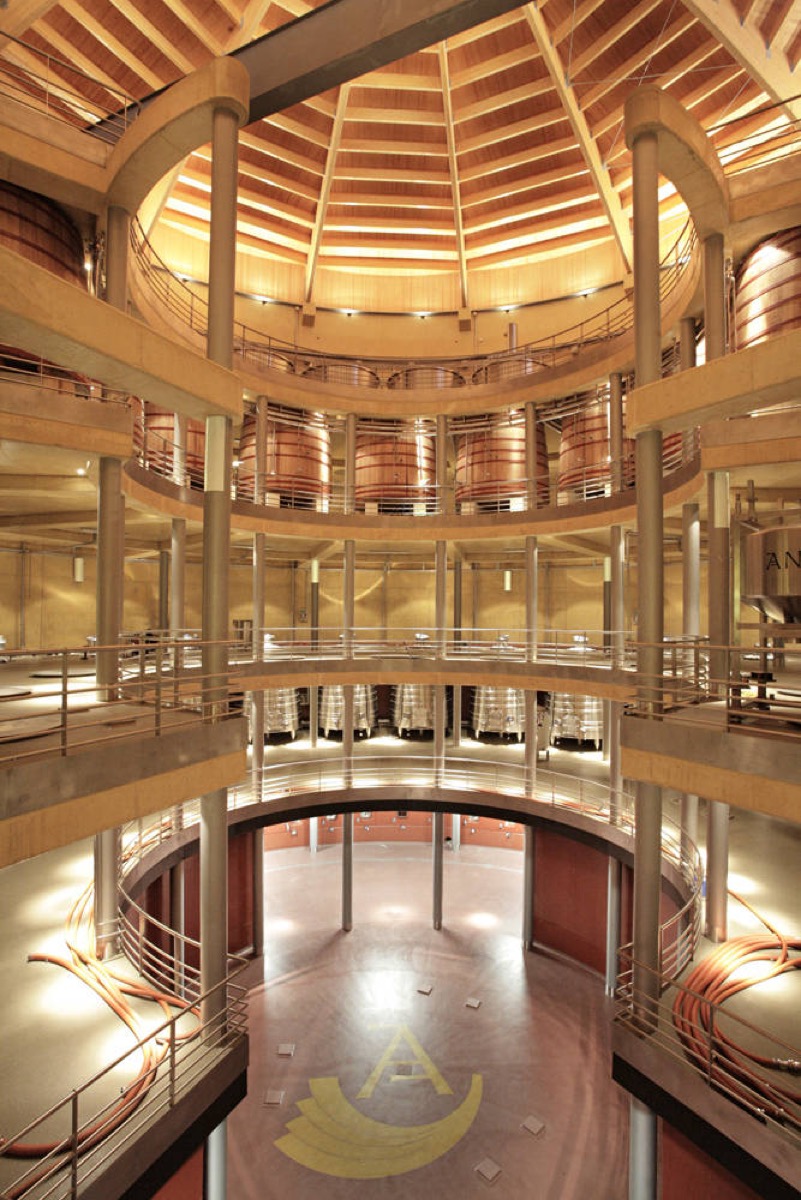
In 2012 it went into bankruptcy, due in part to the crisis of 2008-2011, and despite the fact that sales of Rioja were quite stable over that period. It had debts of € 24 million (part held by the construction company) and liabilities of € 6.3 million, as compared to fixed assets of € 5.7 million, and wine in barrels worth € 2.9 million.
In 2008 Bodegas Protos in Peñafiel, Valladolid, inaugurated a new winery, connected to the existing facilities through a tunnel. Designed by Rogers Stirk Harbour + Partners and Alonso Balaguer & Arquitectos Asociados, it covers nearly 20,000 square metres and cost around € 18 million. The facility can process 1,000 tons of grapes a year.
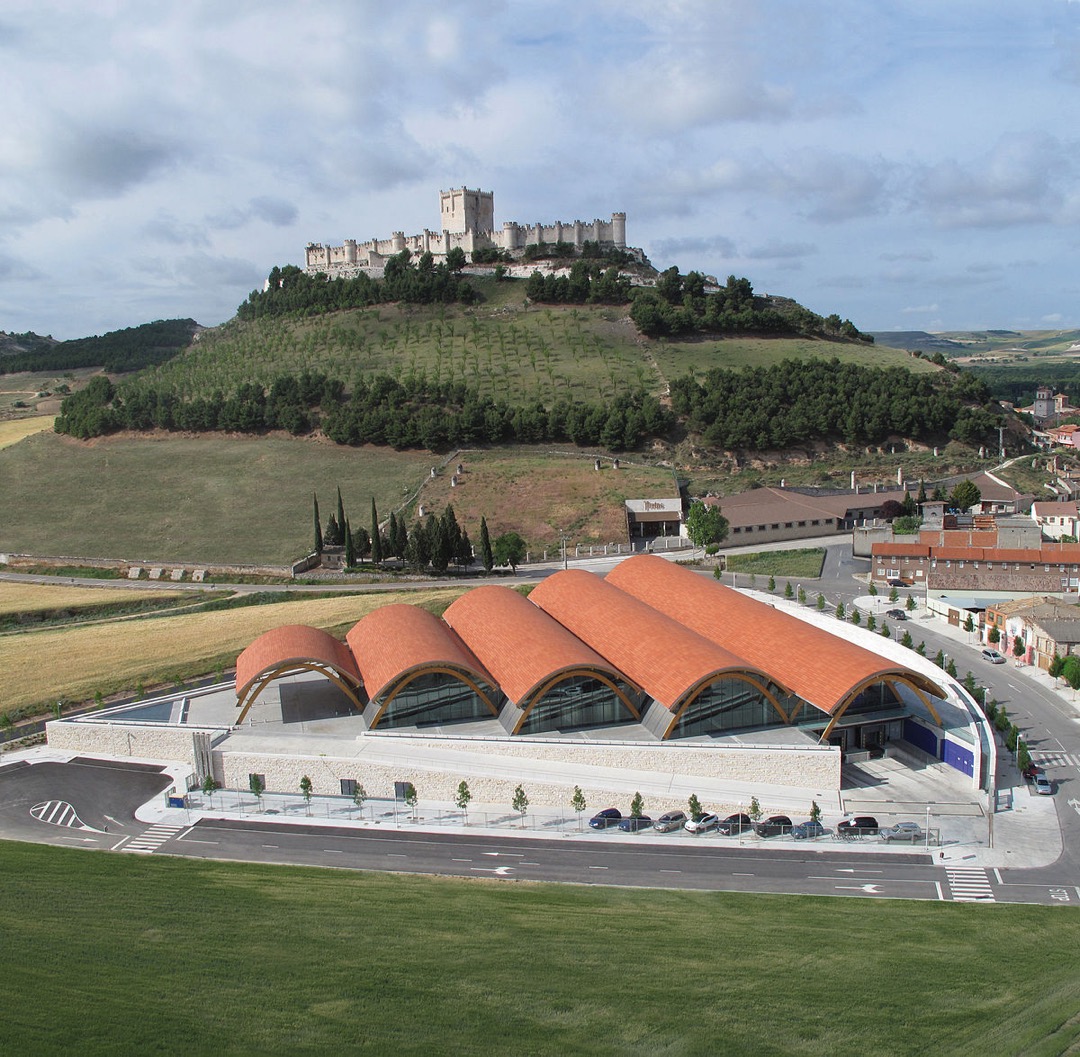
The building design is a contemporary reinterpretation of the traditional winery, i.e. most of the winery’s internal area is underground, where the thermal mass of the ground is used to keep the wine cool, with the production area at ground level beneath a dramatic vaulted wooden roof.
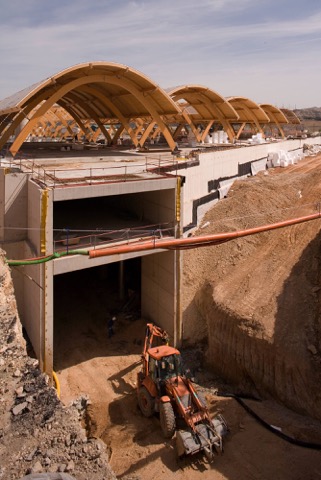
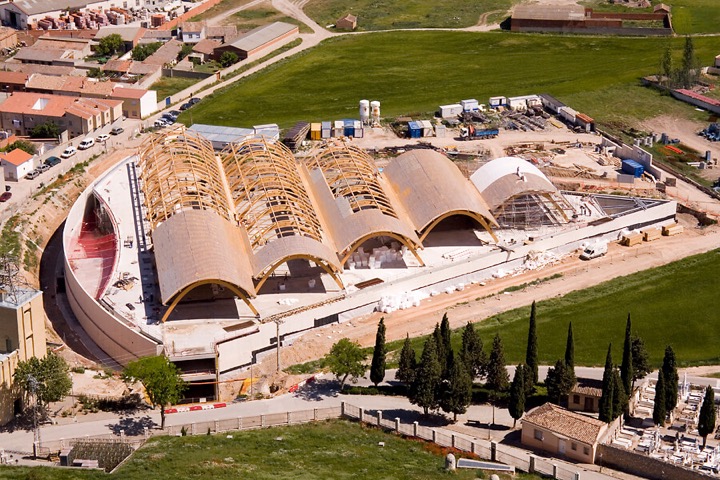
Compositionally, the winery is conceived as a light, articulated structure that sits on a solid base or plinth. The plinth anchors the building to the ground as its volume is mainly buried underground. A large double-height space at production level is covered by interlinked timber vaults to ensure an open and flexible space. This accommodates the fermentation and storage vats as well as the bottling plant, packaging equipment, technical areas and vehicle access bays. At ground level, a modular system of laminated timber arches creates five arches each spanning 18 metres. The roof itself appears to float above these arches, as it is separated by a series of steel props.
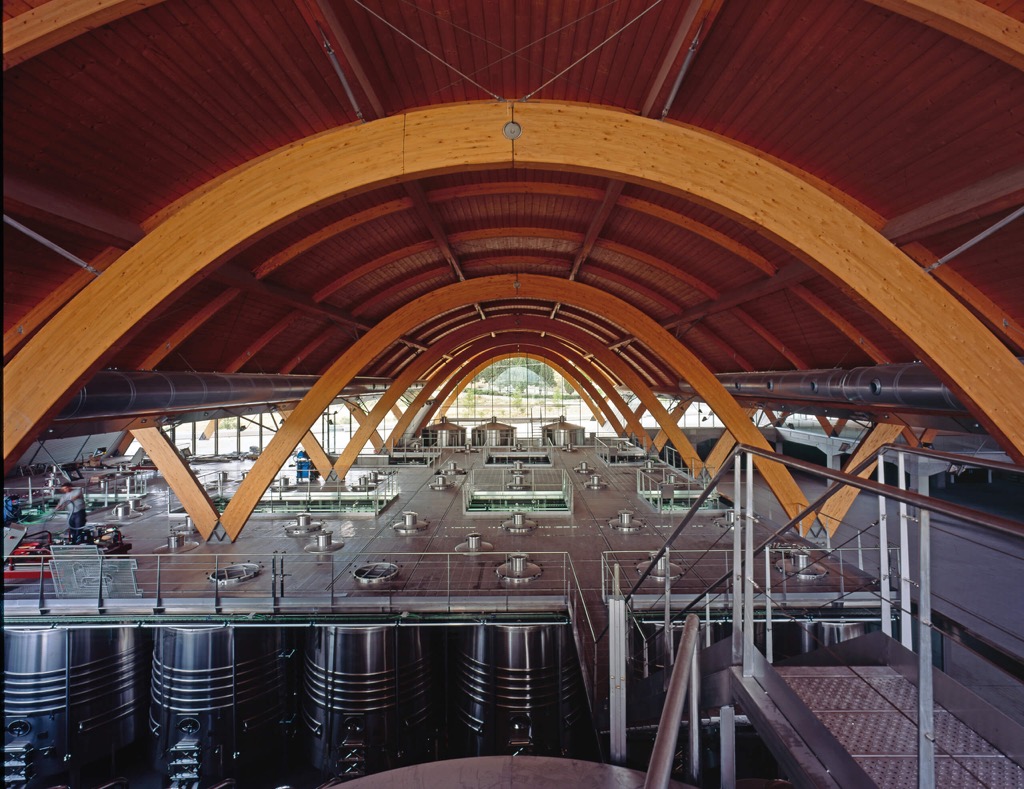
Terracotta roofing tiles are common to the architecture of the region, and they create a ventilated cavity, allowing the sun’s heat to be dissipated rather than radiate towards the inside of the building. The walls are made of glass and waste stone from a local quarry.
Terra Remota in Empordà, Catalonia, was established in 1999, and is a 56-hectares property (27-hectares planted) with a winery designed by Pepe Cortés and Nacho Ferrer (inaugurated in 2008).
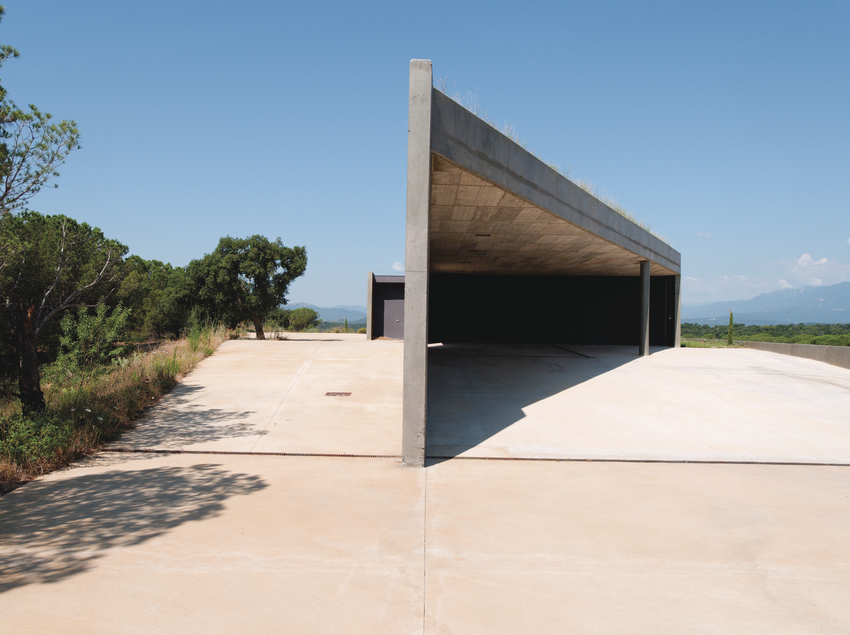
The winery is broken up into three semi-buried interconnected buildings that extend in a graded manner over a north-facing slope. The orientation of this slope and the landscaping of the roofs protect the interior of the winery from excessive. The upper building houses the grape reception space and contains the winemaking cellar. Grapes enter at the highest level gravity fills the tanks of in a cellar situated around four metres below. The intermediate building is the storage and bottling cellar.and the third building is the cask cellar situated further below, where it enjoys stable humidity and temperature conditions.
The Torres estate in decided to build the Bodega Waltraud to present the estates wines. I guess the name comes from Waltraud Maczassek who's paintings hang in the tasting room, and who is the wife of Miguel A. Torres, president of the company.
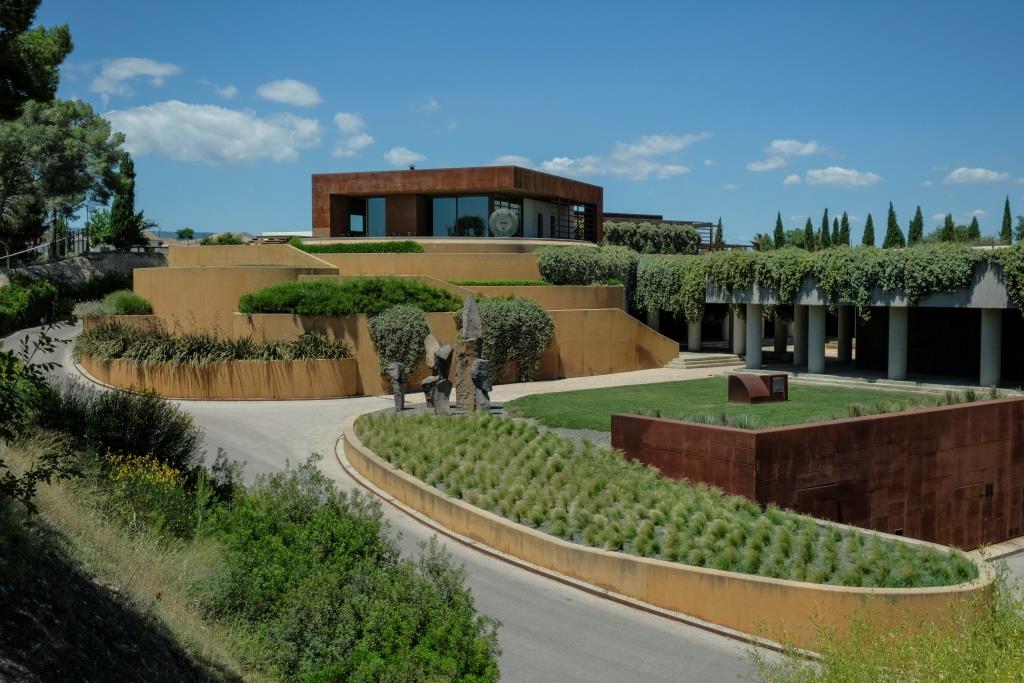
The building was inaugurated in 2008, and was designed by BC Estudio Architects (the same who designed the winery Stags' Leap in Napa County, in 2015).
Planting starting in 1979 in Can Rafols dels Caus, in Avinyonet del Penedés, near Barcelona, although the estate was known to have existed already in 992. However, it was only in 2009 that they completed the building of the "new" bodega.
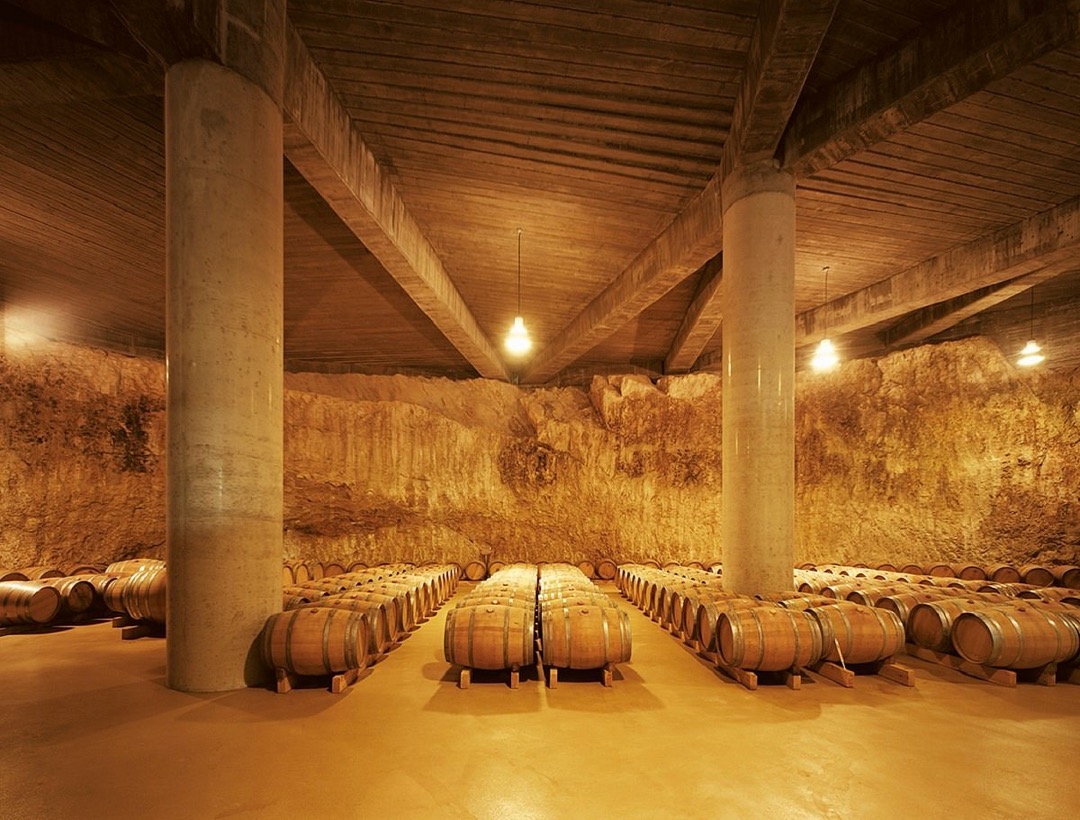
I wrote "new" because the Italian architect Paolo Deganello approached the building in a different way. He recognised that many wineries are built by making a large hole in the ground, and then the excavated earth is put back around or above the building creating a new small artificial mountain. The result is more or less underground, and thus more or less air-conditioned. The earth has always performed the function of thermal insulator and depending upon how well the cellars are protected, the greater the role of the artificial refrigeration system and the greater the waste of energy required for refrigeration. Today cellars are built to both produce wine, and increasingly to show off, i.e. to entice the consumer to visit and buy the wine. This time the architect built the cellar almost entirely in the limestone rock of Can Ràfols, superimposing the wine production cycle on the natural fractures of the rocky complex. As much as possible he retained the rock walls, cleaned of sedimented earth, adding prefabricated components for the roof. For example, the ageing area for the barrels was entire dug into the rock as shown above.
Bodega Portia, part of the Faustino Group, is a winery designed by the studio Foster & Partners, and inaugurated in October 2010. It is located in the Ribera del Duero, and is designed around as a trefoil, or three-pointed star expresses the three main stages of production, i.e. fermentation in steel vats, ageing in oak barrels, and finally, ageing in bottles.
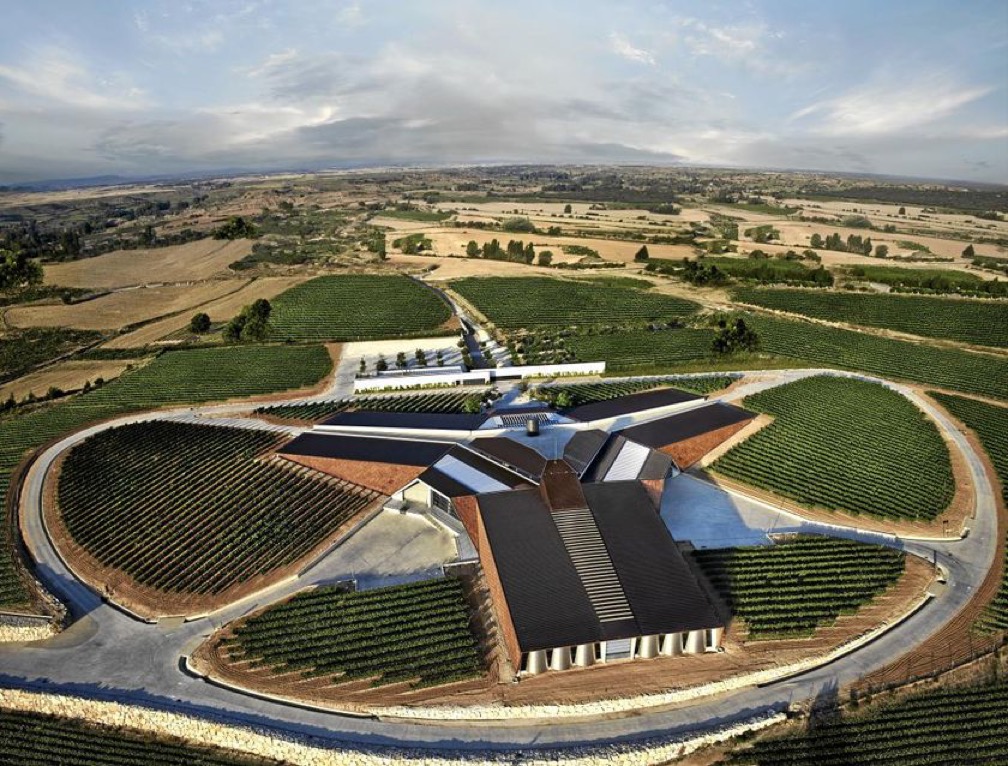
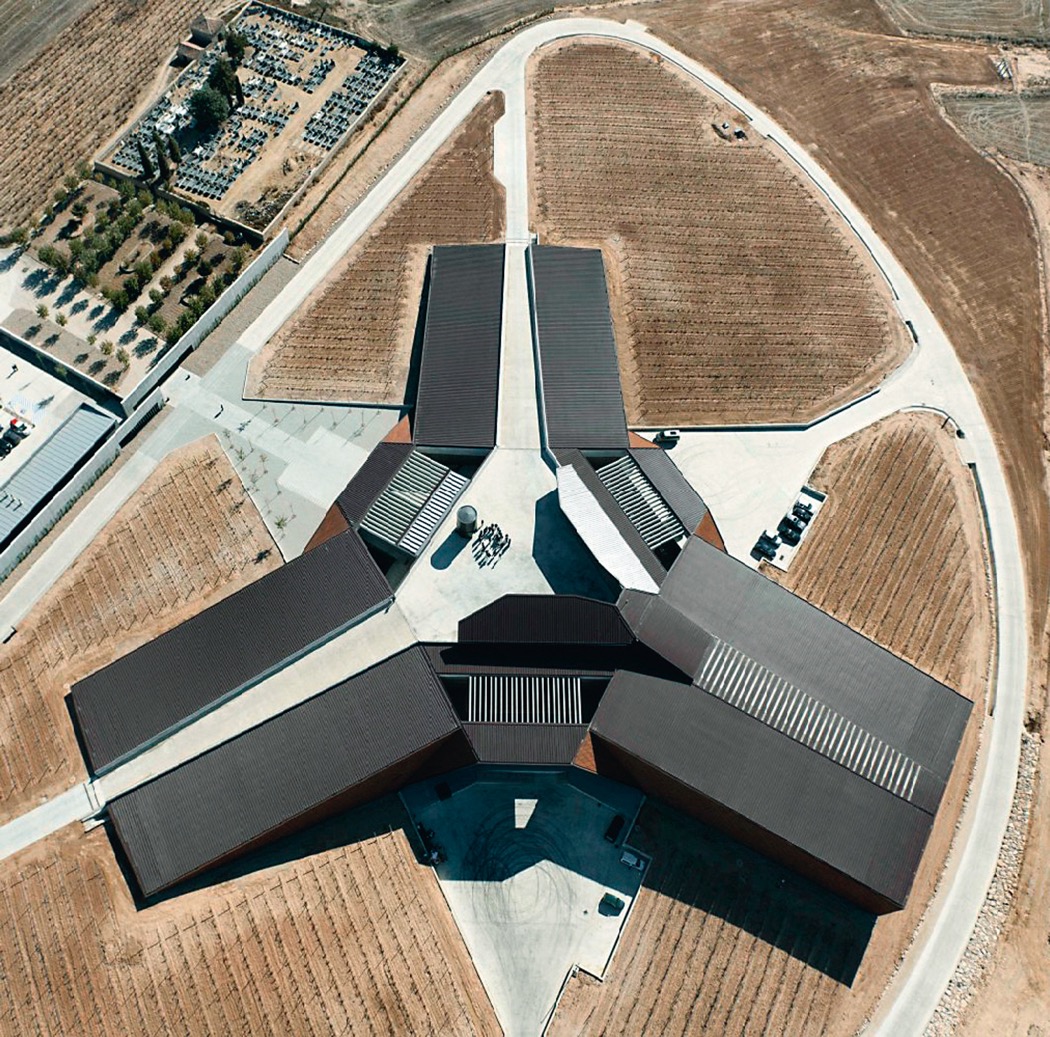
The grapes are delivered via the roof, where they are dropped directly into the hopper. Gravity then moves the harvest around the building, maximising energy efficiency and minimising damage to the grapes. The fermentation wing is exposed to the outside, allowing carbon dioxide to escape naturally.
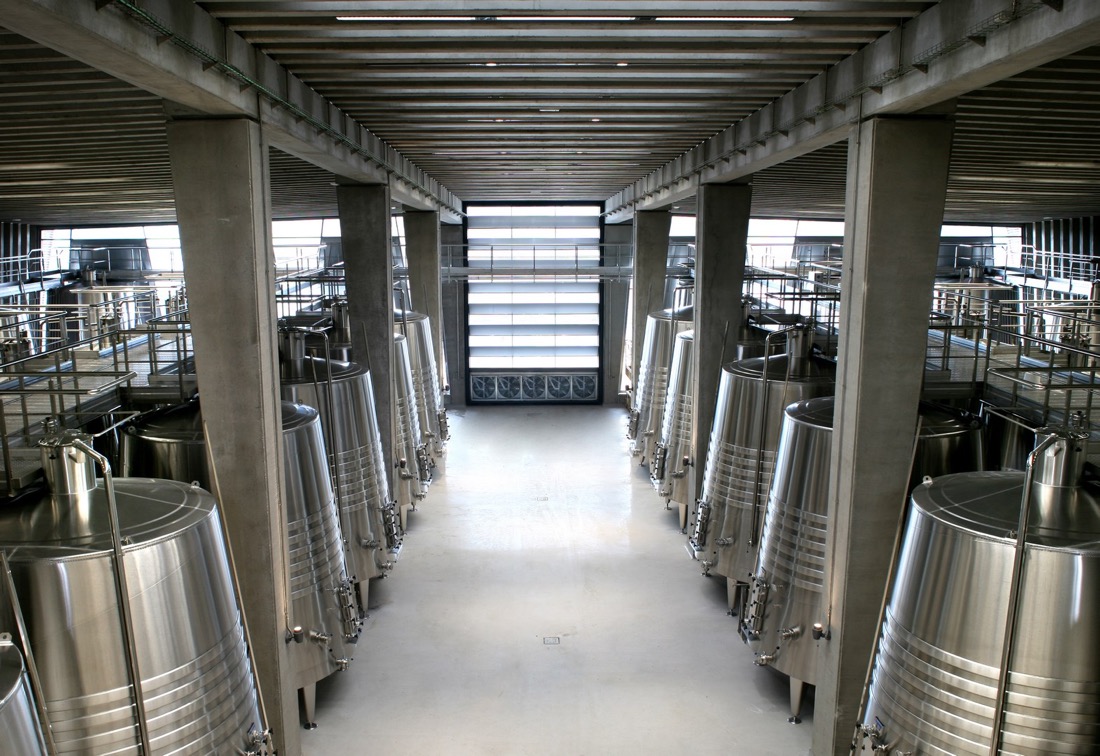
The wings containing the barrel and bottle cellars are partly dug into the sloping site. The 12,500 square-metre facility has a production capacity of one million bottles per year.
The Bodega de La Grajera dates from 2011 and is unusual in that it is owned by the Government of La Rioja (Gobierno de La Rioja), and so has two functions, firstly to produce wine, and secondly to disseminating information about Rioja wine.
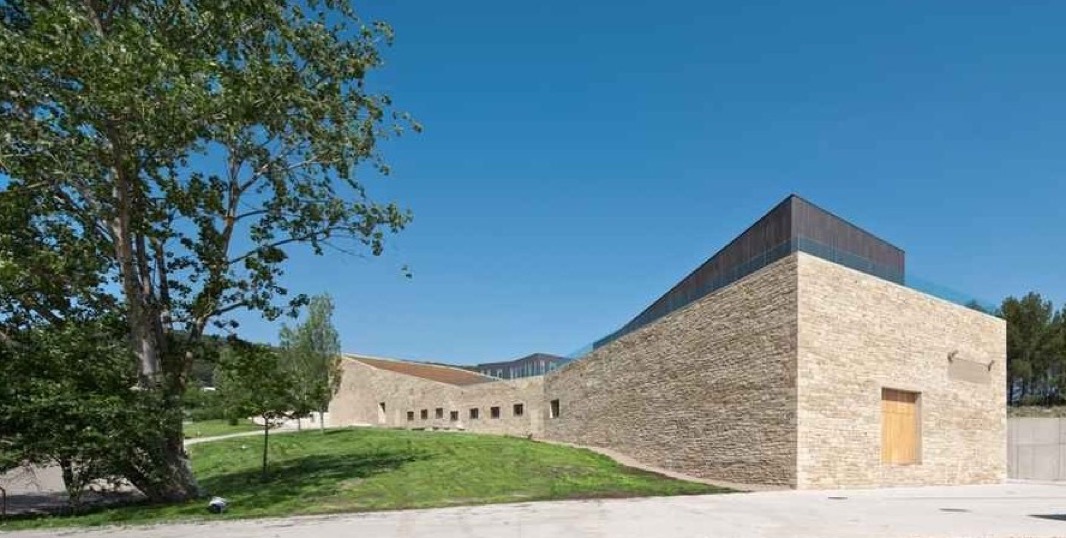
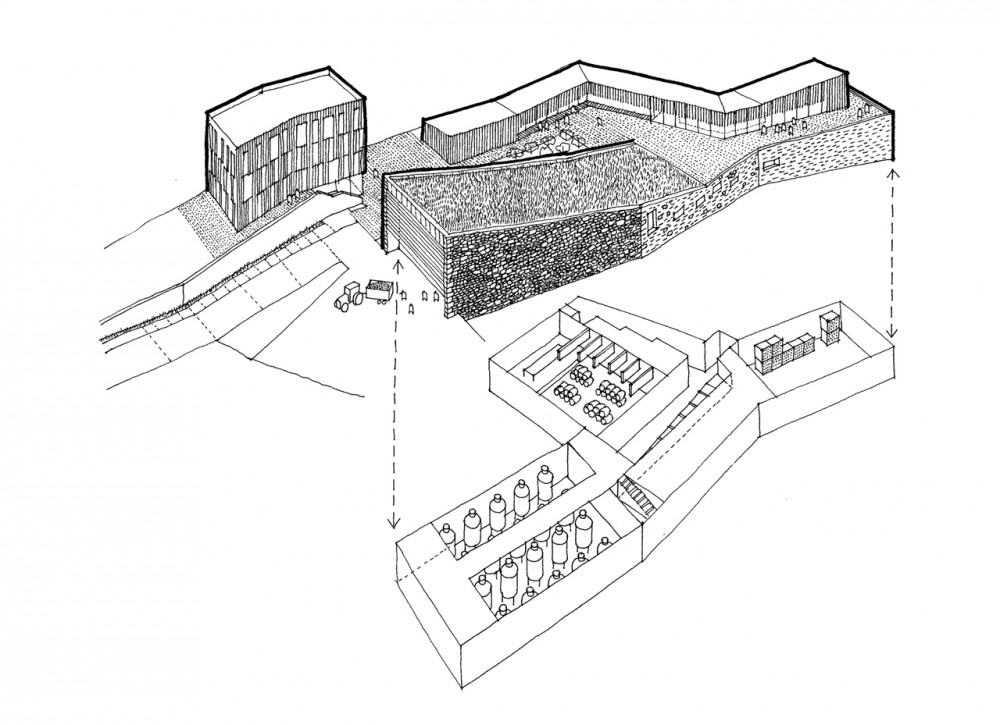
Built near Logroño, it consists of a large semi-buried sandstone building housing the production area, and the "institutional" part of the winery is an elongated body of glass and dark ceramic. The sloping grass-covered roof of the production area increases its thermal insulation, and the design reduces the need for mechanical ventilation for both the processing and tasting areas.
Javier Arizcuren, is an oddity, because he is both architect and wine producer. As an architect his projects included the Bodega Marqués de Terán (2006) and the later Finca Los Arandinos wineries and, more recently, the recovery of the 2-kilometres long underground cellars of the historical Conde de los Andes in Ollauri. However, since 2011 he has been producing wine on the family estate in Quel, in the so-called Rioja Baja.
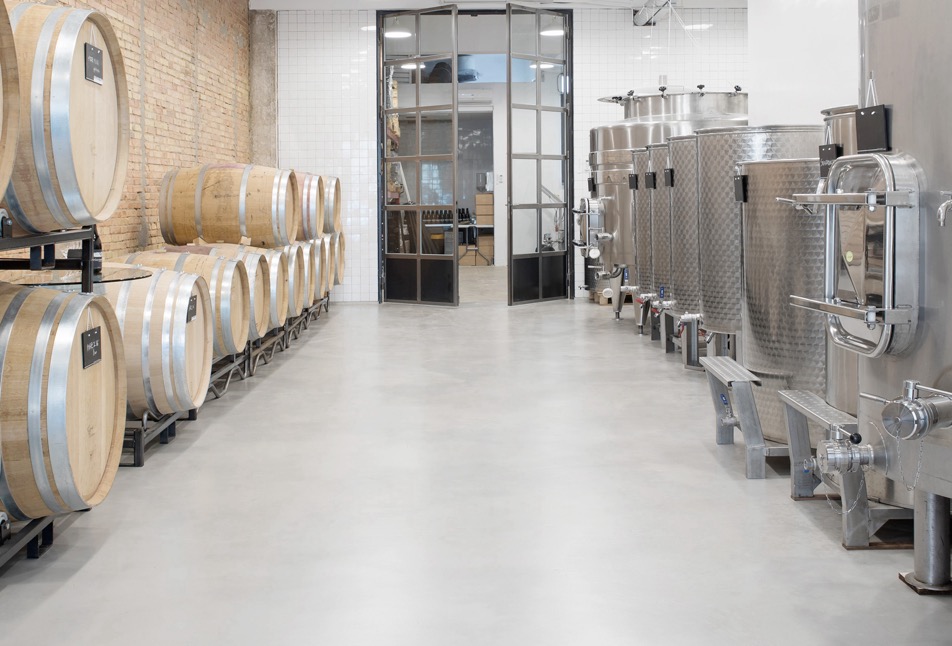
The reason I mention him here is that since 2016 he opened the first "urban winery" in the centre of Logroño, where the entire wine making process from de-stemming, through vatting and fermentation, through to bottling and labelling is performed in little more than 130 square metres.
What I hope I have shown above is that architecture of Spanish wineries is not limited to "exceptional pairings" such as Marqués de Riscal-Gehry, Ysios-Calatrava, Villa Tondonia-Hadid and Faustino-Foster.